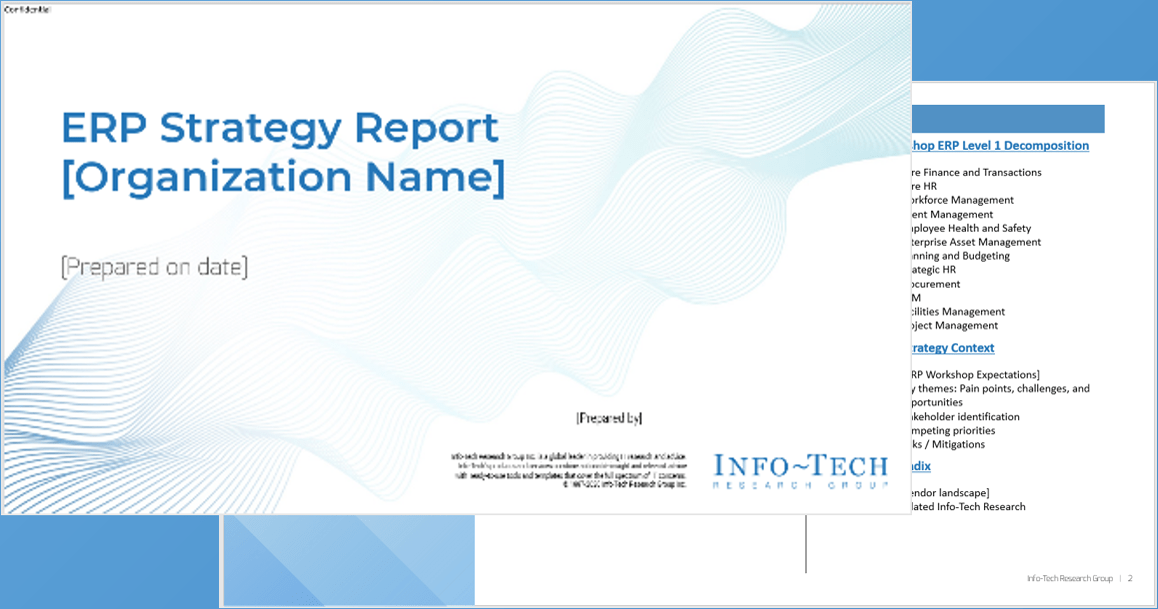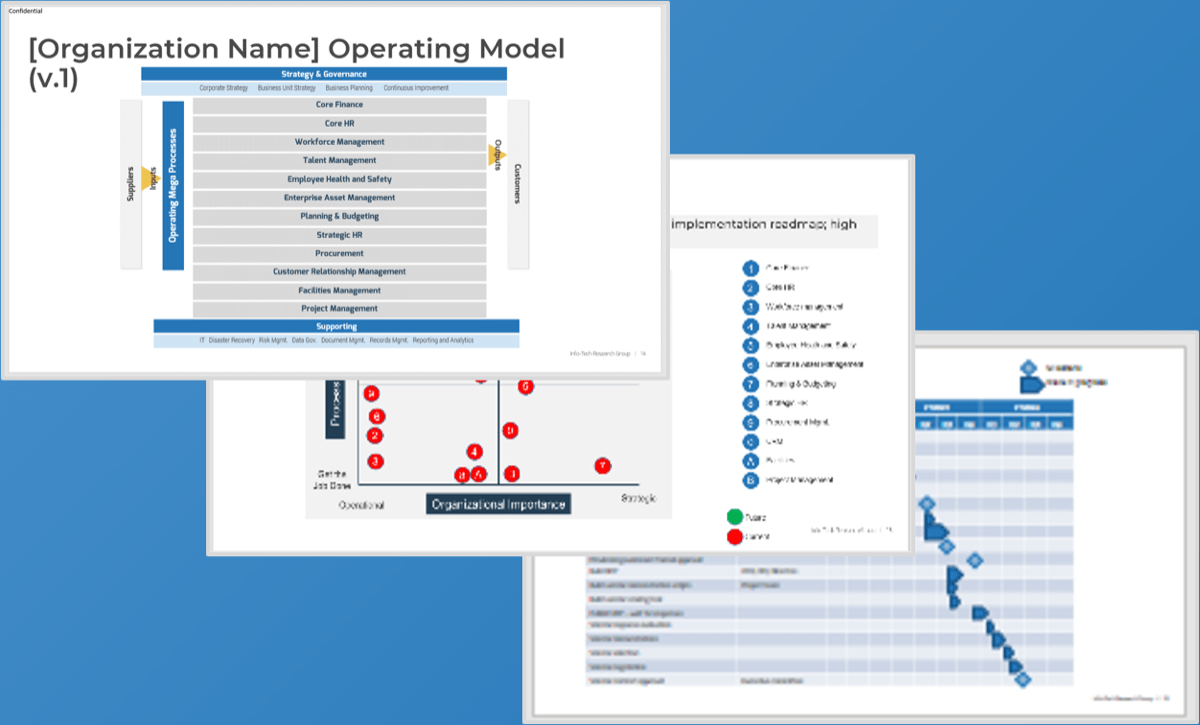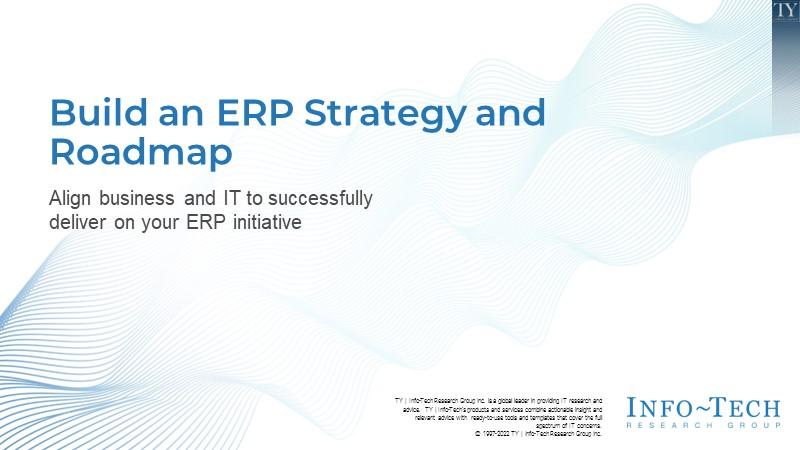
Build an ERP Strategy and Roadmap
- Organizations often do not know where to start with an ERP project.
- They focus on tactically selecting and implementing the technology.
- ERP projects are routinely reported as going over budget, over schedule, and they fail to realize any benefits.
Our Advice
Critical Insight
- An ERP strategy is an ongoing communication tool for the business.
- Accountability for ERP success is shared between IT and the business.
- An actionable roadmap provides a clear path to benefits realization.
Impact and Result
- Align the ERP strategy and roadmap with business priorities, securing buy-in from the business for the program.
- Identification of gaps, needs, and opportunities in relation to business processes; ensuring the most critical areas are addressed.
- Assess alternatives for the critical path(s) most relevant to your organization’s direction.
Build an ERP Strategy and Roadmap Research & Tools
Besides the small introduction, subscribers and consulting clients within this management domain have access to:
1. Build an ERP Strategy and Roadmap – A comprehensive guide to align business and IT on what the organization needs from their ERP.
A business-led, top-management-supported initiative partnered with IT has the greatest chance of success.
- Build an ERP Strategy and Roadmap – Phases 1-4
- ERP Strategy Report Template
Workshop: Build an ERP Strategy and Roadmap
Workshops offer an easy way to accelerate your project. If you are unable to do the project yourself, and a Guided Implementation isn't enough, we offer low-cost delivery of our project workshops. We take you through every phase of your project and ensure that you have a roadmap in place to complete your project successfully.
1 Introduction to ERP
The Purpose
To build understanding and alignment between business and IT on what an ERP is and the goals for the project
Key Benefits Achieved
Clear understanding of how the ERP supports the organizational goals
What business processes the ERP will be supporting
An initial understanding of the effort involved
Activities
1.1 Introduction to ERP
1.2 Background
1.3 Expectations and goals
1.4 Align business strategy
1.5 ERP vision and guiding principles
1.6 ERP strategy model
1.7 ERP operating model
Outputs
ERP strategy model
ERP Operating model
2 Build the ERP operation model
The Purpose
Generate an understanding of the business processes, challenges, and application portfolio currently supporting the organization.
Key Benefits Achieved
An understanding of the application portfolio supporting the business
Detailed understanding of the business operating processes and pain points
Activities
2.1 Build application portfolio
2.2 Map the level 1 ERP processes including identifying stakeholders, pain points, and key success indicators
2.3 Discuss process and technology maturity for each level 1 process
Outputs
Application portfolio
Mega-processes with level 1 process lists
3 Project set up
The Purpose
A project of this size has multiple stakeholders and may have competing priorities. This section maps those stakeholders and identifies their possible conflicting priorities.
Key Benefits Achieved
A prioritized list of ERP mega-processes based on process rigor and strategic importance
An understanding of stakeholders and competing priorities
Initial compilation of the risks the organization will face with the project to begin early mitigation
Activities
3.1 ERP process prioritization
3.2 Stakeholder mapping
3.3 Competing priorities review
3.4 Initial risk register compilation
Outputs
Prioritized ERP operating model
Stakeholder map.
Competing priorities list.
Initial risk register.
4 Roadmap and presentation review
The Purpose
Select a future state and build the initial roadmap to set expectations and accountabilities.
Key Benefits Achieved
Identification of the future state
Initial roadmap with expectations on accountability and timelines
Activities
4.1 Discuss future state options
4.2 Build initial roadmap
4.3 Review of final deliverable
Outputs
Future state options
Initiative roadmap
Draft final deliverable
Further reading
Build an ERP Strategy and Roadmap
Align business and IT to successfully deliver on your ERP initiative
Table of Contents
|
Analyst Perspective |
Phase 3: Plan Your Project |
|
Executive Summary |
Step 3.1: Stakeholders, risk, and value |
|
Phase 1: Build Alignment and Scope |
Step 3.2: Project set up |
|
Step 1.1: Aligning Business and IT |
Phase 4: Next Steps |
|
Step 1.2: Scope and Priorities |
Step 4.1: Build your roadmap |
|
Phase 2: Define Your ERP |
Step 4.2: Wrap up and present |
|
Step 2.1: ERP business model |
Summary of Accomplishment |
|
Step 2.2: ERP processes and supporting applications |
Research Contributors |
|
Step 2.3: Process pains, opportunities, and maturity |
Related Info-Tech Research |
|
Bibliography |
Build an ERP Strategy and Roadmap
Align business and IT to successfully deliver on your ERP initiative
EXECUTIVE BRIEF
Analyst Perspective
A foundational ERP strategy is critical to decision making.

Enterprise resource planning (ERP) is a core tool that the business leverages to accomplish its goals. An ERP that is doing its job well is invisible to the business. The challenges come when the tool is no longer invisible. It has become a source of friction in the functioning of the business
ERP systems are expensive, their benefits are difficult to quantify, and they often suffer from poor user satisfaction. Post-implementation, technology evolves, organizational goals change, and the health of the system is not monitored. This is complicated in today’s digital landscape with multiple integration points, siloed data, and competing priorities.
Too often organizations jump into selecting replacement systems without understanding the needs of the organization. Alignment between business and IT is just one part of the overall strategy. Identifying key pain points and opportunities, assessed in the light of organizational strategy, will provide a strong foundation to the transformation of the ERP system.
Robert Fayle
Research Director, Enterprise Applications
Info-Tech Research Group
Executive Summary
Your Challenge
Organizations often do not know where to start with an ERP project. They focus on tactically selecting and implementing the technology but ignore the strategic foundation that sets the ERP system up for success. ERP projects are routinely reported as going over budget, over schedule, and they fail to realize any benefits.
Common Obstacles
ERP projects impact the entire organization – they are not limited to just financial and operating metrics. The disruption is felt during both implementation and in the production environment.
Missteps early on can cost time, financial resources, and careers. Roughly 55% of ERP projects reported being over budget, and two-thirds of organizations implementing ERP realized less than half of their anticipated benefits.
Info-Tech’s Approach
Obtain organizational buy-in and secure top management support. Set clear expectations, guiding principles, and critical success factors.
Build an ERP operating model/business model that identifies process boundaries, scope, and prioritizes requirements. Assess stakeholder involvement, change impact, risks, and opportunities.
Understand the alternatives your organization can choose for the future state of ERP. Develop an actionable roadmap and meaningful KPIs that directly align with your strategic goals.
Info-Tech Insight
Accountability for ERP success is shared between IT and the business. There is no single owner of an ERP. A unified approach to building your strategy promotes an integrated roadmap so all stakeholders have clear direction on the future state.
Insight summary
Enterprise resource planning (ERP) systems facilitate the flow of information across business units. It allows for the seamless integration of systems and creates a holistic view of the enterprise to support decision making.
In many organizations, the ERP system is considered the lifeblood of the enterprise. Problems with this key operational system will have a dramatic impact on the ability of the enterprise to survive and grow.
A measured and strategic approach to change will help mitigate many of the risks associated with ERP projects, which will avoid the chances of these changes becoming the dreaded “career killers.”
A business led, top management supported initiative partnered with IT has the greatest chance of success.
- A properly scoped ERP project reduces churn and provides all parts of the business with clarity.
- This blueprint provides the business and IT the methodology to get the right level of detail for the business processes that the ERP supports so you can avoid getting lost in the details.
- Build a successful ERP Strategy and roadmap by:
- Aligning and prioritizing key business and technology drivers.
- Clearly defining what is in and out of scope for the project.
- Providing a clear picture of how the business process and underlying applications support the business strategic priorities.
- Pulling it all together into an actionable roadmap.
Enterprise Resource Planning (ERP)
What is ERP?
Enterprise resource planning (ERP) systems facilitate the flow of information across business units. They allow for the seamless integration of systems and create a holistic view of the enterprise to support decision making.
In many organizations, the ERP system is considered the lifeblood of the enterprise. Problems with this key operational system will have a dramatic impact on the ability of the enterprise to survive and grow.
An ERP system:
- Automates processes, reducing the amount of manual, routine work.
- Integrates with core modules, eliminating the fragmentation of systems.
- Centralizes information for reporting from multiple parts of the value chain to a single point.
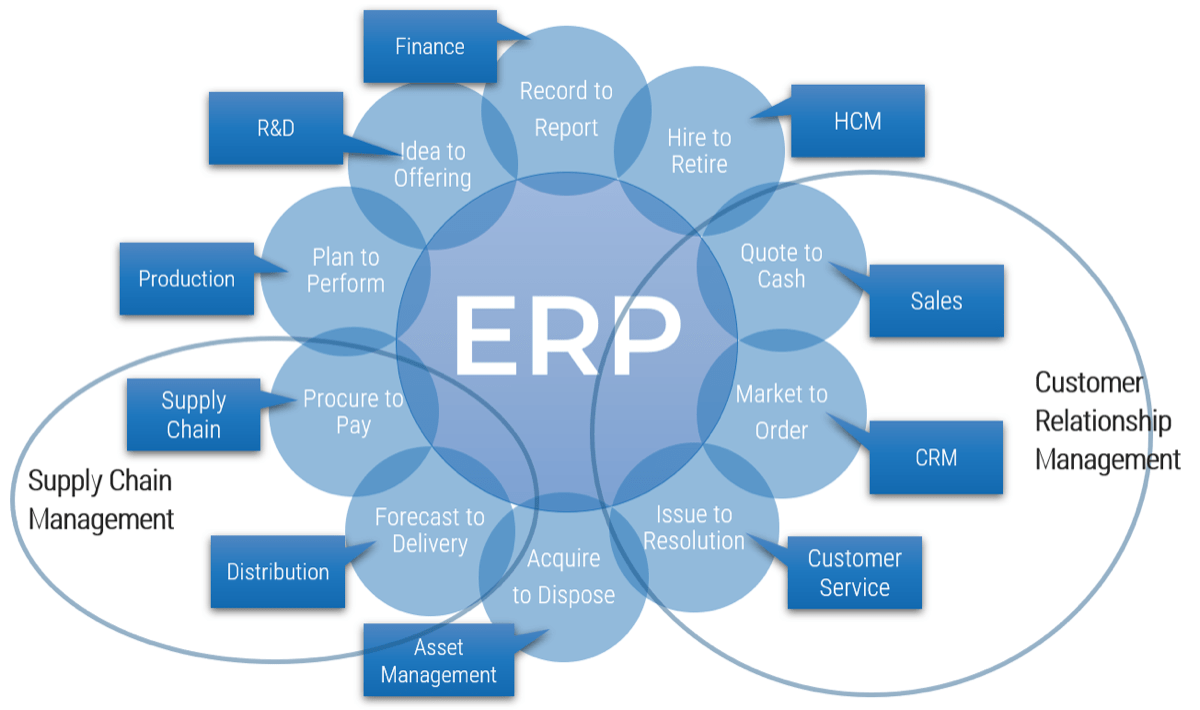
ERP use cases:
- Product-Centric
Suitable for organizations that manufacture, assemble, distribute, or manage material goods. - Service-Centric
Suitable for organizations that provide and manage field services and/or professional services.
ERP by the numbers
50-70%
Statistical analysis of ERP projects indicates rates of failure vary from 50 to 70%. Taking the low end of those analyst reports, one in two ERP projects is considered a failure. (Source: Saxena and Mcdonagh)
85%
Companies that apply the principles of behavioral economics outperform their peers by 85% in sales growth and more than 25% in gross margin. (Source: Gallup)
40%
Nearly 40% of companies said functionality was the key driver for the adoption of a new ERP. (Source: Gheorghiu)
ERP dissatisfaction
| Drivers of Dissatisfaction | |||
Business
|
Data
|
People and teams
|
Technology
|
Finance, IT, Sales, and other users of the ERP system can only optimize ERP with the full support of each other. The cooperation of the departments is crucial when trying to improve ERP technology capabilities and customer interaction.
Info-Tech Insight
While technology is the key enabler of building strong customer experiences, there are many other drivers of dissatisfaction. IT must stand shoulder-to-shoulder with the business to develop a technology framework for ERP.
Info-Tech’s methodology for developing a foundational ERP strategy and roadmap
| 1. Build alignment and scope | 2. Define your ERP | 3. Plan your project | 4. Next Steps | |
| Phase Steps |
|
|
|
|
| Phase Outcomes | Discuss organizational goals and how to advance those using the ERP system. Establish the scope of the project and ensure that business and IT are aligned on project priorities. | Build the ERP business model then move on to the top level (mega) processes and an initial list of the sub-processes. Generate a list of applications that support the identified processes. Conclude with a complete view of the mega-processes and their sub-processes. | Map out your stakeholders to evaluate their impact on the project, build an initial risk register and discuss group alignment. Conclude the phase by setting the initial core project team and their accountabilities to the project. | Review the different options to solve the identified pain points then build out a roadmap of how to get to that solution. Build a communication plan as part of organizational change management, which includes the stakeholder presentation. |
Blueprint deliverables
Each step of this blueprint is accompanied by supporting deliverables to help you accomplish your goals:
|
ERP Strategy ReportComplete an assessment of processes, prioritization, and pain points, and create an initiative roadmap.
|
ERP Business ModelAlign your business and technology goals and objectives in the current environment. |
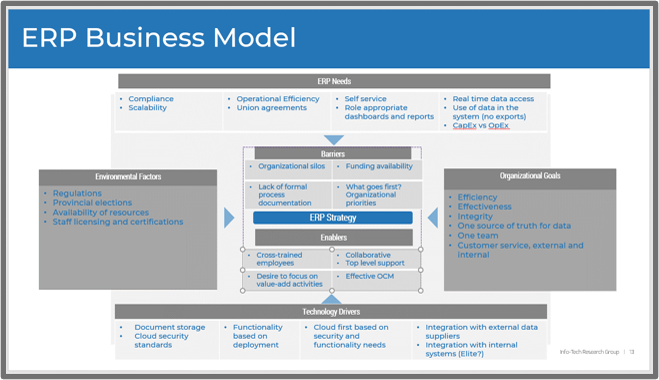
|
ERP Operating ModelIdentify and prioritize your ERP top-level processes. |
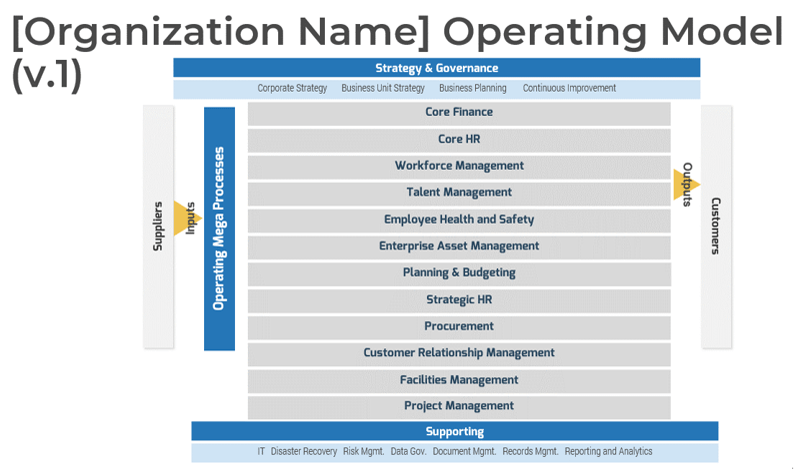
|
ERP Process PrioritizationAssess ERP processes against the axes of rigor and strategic importance. |
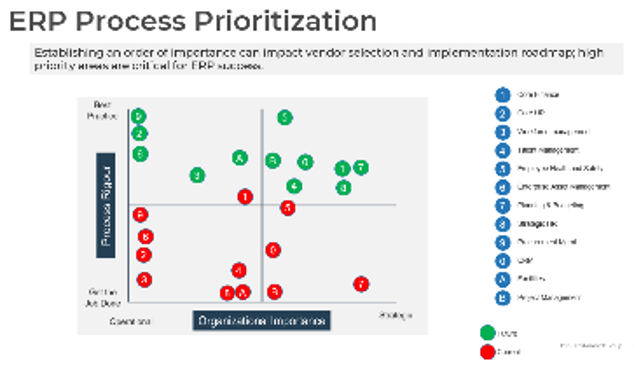
|
ERP Strategy RoadmapA data-driven roadmap of how to address the ERP pain points and opportunities. |
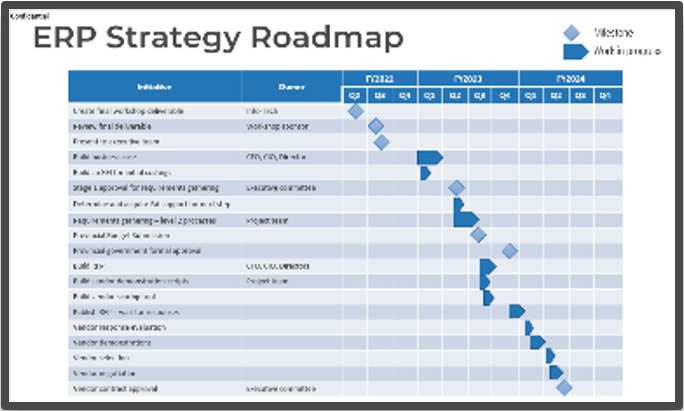
|
Executive Brief Case Study
INDUSTRY: Aerospace
SOURCE: Panorama, 2021
Aerospace organization assesses ERP future state from opportunities, needs, and pain points
Challenge
Several issues plagued the aerospace and defense organization. Many of the processes were ad hoc and did not use the system in place, often relying on Excel. The organization had a very large pain point stemming from its lack of business process standardization and oversight. The biggest gap, however, was from the under-utilization of the ERP software.
Solution
By assessing the usage of the system by employees and identifying key workarounds, the gaps quickly became apparent. After assessing the organization’s current state and generating recommendations from the gaps, it realized the steps needed to achieve its desired future state. The analysis of the pain points generated various needs and opportunities that allowed the organization to present and discuss its key findings with executive leadership to set milestones for the project.
Results
The overall assessment led the organization to the conclusion that in order to achieve its desired future state and maximize ROI from its ERP, the organization must address the internal issues prior to implementing the upgraded software.
Info-Tech offers various levels of support to best suit your needs
DIY Toolkit |
Guided Implementation |
Workshop |
Consulting |
| "Our team has already made this critical project a priority, and we have the time and capability, but some guidance along the way would be helpful." | "Our team knows that we need to fix a process, but we need assistance to determine where to focus. Some check-ins along the way would help keep us on track." | "We need to hit the ground running and get this project kicked off immediately. Our team has the ability to take this over once we get a framework and strategy in place." | "Our team does not have the time or the knowledge to take this project on. We need assistance through the entirety of this project." |
Diagnostics and consistent frameworks used throughout all four options
Guided Implementation
What does a typical GI on this topic look like?
A Guided Implementation (GI) is a series of calls with an Info-Tech analyst to help implement our best practices in your organization.
A typical GI is between eight to twelve calls over the course of four to six months.
Phase 1
- Call #1: Scoping call to understand the current situation.
- Call #2: Establish business & IT alignment and project scope.
Phase 2
- Call #3: Discuss the ERP Strategy business model and mega-processes.
- Call #4: Begin the drill down on the level 1 processes.
Phase 3
- Call #5: Establish the stakeholder map and project risks.
- Call #6: Discuss project setup including stakeholder commitment and accountability.
Phase 4
- Call #7: Discuss resolution paths and build initial roadmap.
- Call #8: Summarize results and plan next steps.
Workshop Overview
Contact your account representative for more information.
workshops@infotech.com1-888-670-8889
| Day 1 | Day 2 | Day 3 | Day 4 | Day 5 | |
| Activities |
Introduction to ERP1.1 Introduction to ERP 1.2 Background 1.3 Expectations and goals 1.4 Align business strategy 1.5 ERP vision and guiding principles 1.6 ERP strategy model 1.7 ERP operating model |
Build the ERP operating model2.1 Build application portfolio 2.2 Map the level 1 ERP processes including identifying stakeholders, pain points, and key success indicators 2.3 Discuss process and technology maturity for each level 1 process |
Project set up3.1 ERP process prioritization 3.2 Stakeholder mapping 3.3 Competing priorities review 3.4 Initial risk register compilation 3.5 Workshop retrospective |
Roadmap and presentation review4.1 Discuss future state options 4.2 Build initial roadmap 4.3 Review of final deliverable |
Next Steps and wrap-up (offsite)5.1 Complete in-progress deliverables from previous four days 5.2 Set up review time for workshop deliverables and to discuss next steps |
| Deliverables |
|
|
|
|
|
Build an ERP Strategy and Roadmap
Phase 1
Build alignment and scope
Phase 1
|
Phase 2
|
Phase 3
|
Phase 4
|
This phase will walk you through the following activities:
Build a common language to ensure clear understanding of the organizational needs. Define a vision and guiding principles to aid in decision making and enumerate how the ERP supports achievement of the organizational goals. Define the initial scope of the ERP project. This includes the discussion of what is not in scope.
This phase involves the following participants:
- Primary stakeholders in each value stream supported by the ERP
- ERP Applications support team
Create a compelling case that addresses strategic business objectives
When someone at the organization asks you WHY, you need to deliver a compelling case. The ERP project will receive pushback, doubt, and resistance; if you can’t answer the question WHY, you will be left back-peddling.
When faced with a challenge, prepare for the WHY.
- Why do we need this?
- Why are we spending all this money?
- Why are we bothering?
- Why is this important?
- Why did we do it this way?
- Why did we choose this vendor?
Most organizations can answer “What?”
Some organizations can answer “How?”
Very few organizations have an answer for “Why?”
Each stage of the project will be difficult and present its own unique challenges and failure points. Re-evaluate if you lose sight of WHY at any stage in the project.
Step 1.1
Aligning business and IT
Activities
- 1.1.1 Build a glossary
- 1.1.2 ERP Vision and guiding principles
- 1.1.3 Corporate goals and ERP benefits
This step will walk you through the following activities:
- Building a common language to ensure a clear understanding of the organization’s needs.
- Creating a definition of your vision and identifying the guiding principles to aid in decision making.
- Defining how the ERP supports achievement of the organizational goals.
This step involves the following participants:
- Primary stakeholders in each value stream supported by the ERP
- ERP Applications support team
Outcomes of this step
Business and IT have a shared understanding of how the ERP supports the organizational goals.
Are we all talking about the same thing?
Every group has their own understanding of the ERP system, and they may use the same words to describe different things. For example, is there a difference between procurement of office supplies and procurement of parts to assemble an item for sale? And if they are different, do your terms differ (e.g., procurement versus purchasing)?
| Term(s) | Definition |
| HRMS, HRIS, HCM | Human Resource Management System, Human Resource Information System, Human Capital Management. These represent four capabilities of HR: core HR, talent management, workforce management, and strategic HR. |
| Finance | Finance includes the core functionalities of GL, AR, and AP. It also covers such items as treasury, financial planning and analysis (FP&A), tax management, expenses, and asset management. |
| Supply Chain | The processes and networks required to produce and distribute a product or service. This encompasses both the organization and the suppliers. |
| Procurement | Procurement is about getting the right products from the right suppliers in a timely fashion. Related to procurement is vendor contract management. |
| Distribution | The process of getting the things we create to our customers. |
| CRM | Customer Relationship Management, the software used to maintain records of our sales and non-sales contact with our customers. |
| Sales | The process of identifying customers, providing quotes, and converting those quotes to sales orders to be invoiced. |
| Customer Service | This is the process of supporting customers with challenges and non-sales questions related to the delivery of our products/services. |
| Field Service | The group that provides maintenance services to our customers. |
Activity 1.1.1 Build a glossary
1 hour- As a group, discuss the organization’s functional areas, business capabilities, value streams, and business processes.
- Ask each of the participants if there are terms or “jargon” that they hear used that they may be unclear on or know that others may not be aware of. Record these items in the table along with a description.
- Acronyms are particularly important to document. These are often bandied about without explanation. For example, people outside of finance may not understand that FP&A is short for Financial Planning and Analysis.
Record this information in the ERP Strategy Report Template.
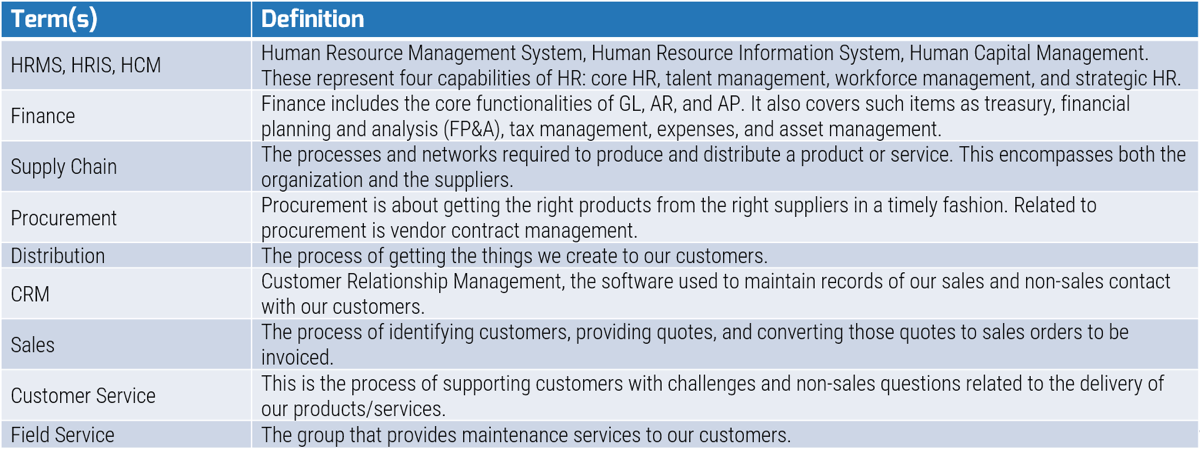
Download the ERP Strategy Report Template
Activity 1.1.1 Working slide
Example/working slide for your glossary. Consider this a living document and keep it up to date.
| Term(s) | Definition |
| HRMS, HRIS, HCM | Human Resource Management System, Human Resource Information System, Human Capital Management. These represent four capabilities of HR: core HR, talent management, workforce management, and strategic HR. |
| Finance | Finance includes the core functionalities of GL, AR, and AP. It also covers such items as treasury, financial planning and analysis (FP&A), tax management, expenses, and asset management. |
| Supply Chain | The processes and networks required to produce and distribute a product or service. This encompasses both the organization and the suppliers. |
| Procurement | Procurement is about getting the right products from the right suppliers in a timely fashion. Related to procurement is vendor contract management. |
| Distribution | The process of getting the things we create to our customers. |
| CRM | Customer Relationship Management, the software used to maintain records of our sales and non-sales contact with our customers. |
| Sales | The process of identifying customers, providing quotes, and converting those quotes to sales orders to be invoiced. |
| Customer Service | This is the process of supporting customers with challenges and non-sales questions related to the delivery of our products/services. |
| Field Service | The group that provides maintenance services to our customers. |
Vision and Guiding Principles
GUIDING PRINCIPLES
Guiding principles are high-level rules of engagement that help to align stakeholders from the outset. Determine guiding principles to shape the scope and ensure stakeholders have the same vision.
Creating Guiding Principles
Guiding principles should be constructed as full sentences. These statements should be able to guide decisions.
EXAMPLES
- [Organization] is implementing an ERP system to streamline processes and reduce redundancies, saving time and money.
- [Organization] is implementing an ERP to integrate disparate systems and rationalize the application portfolio.
- [Organization] is aiming at taking advantage of best industry practices and strives to minimize the level of customization required in solution.
Questions to Ask
- What is a strong statement that will help guide decision making throughout the life of the ERP project?
- What are your overarching requirements for business processes?
- What do you ultimately want to achieve?
- What is a statement that will ensure all stakeholders are on the same page for the project?
Activity 1.1.2 – ERP Vision and Project Guiding Principles
1 hour
- As a group, discuss whether you want to create a separate ERP vision statement or re-state your corporate vision and/or goals.
- An ERP vision statement will provide project-guiding principles, encompass the ERP objectives, and give a rationale for the project.
- Using the corporate vision/goals will remind the business and IT that the project is to find an ERP solution that supports and enhances the organizational objectives.
- Review each of the sample guiding principles provided and ask the following questions:
- Do we agree with the statement?
- Is this statement framed in the language we used internally? Does everyone agree on the meaning of the statement?
- Will this statement help guide our decision-making process?
Record this information in the ERP Strategy Report Template.
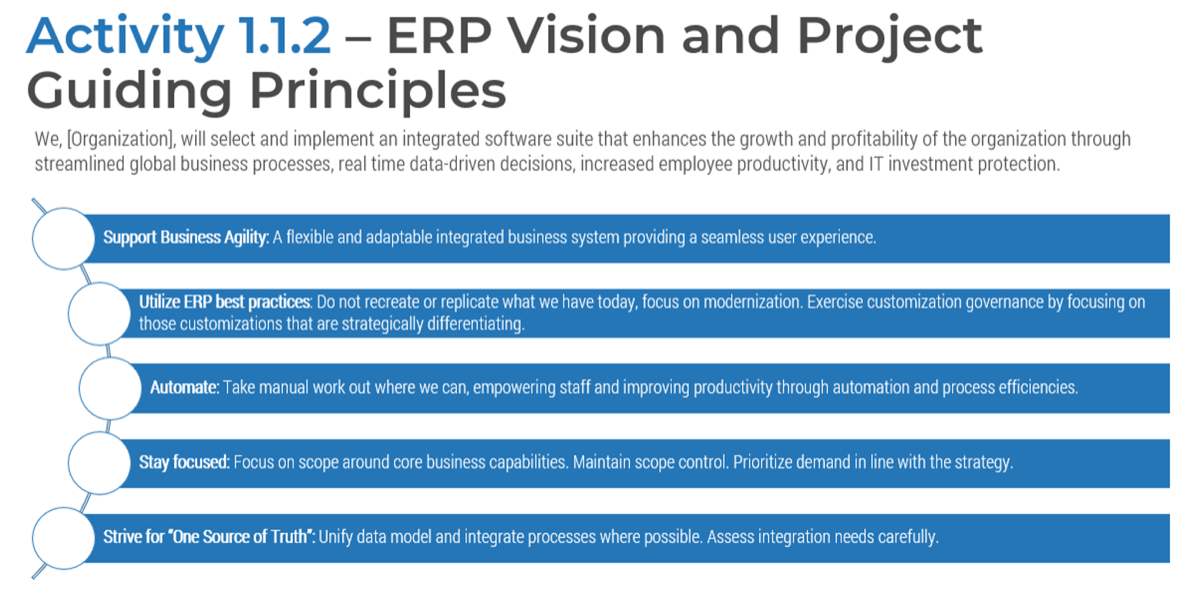
Download the ERP Strategy Report Template
Activity 1.1.2 – ERP Vision and Project Guiding Principles
We, [Organization], will select and implement an integrated software suite that enhances the growth and profitability of the organization through streamlined global business processes, real time data-driven decisions, increased employee productivity, and IT investment protection.
- Support Business Agility: A flexible and adaptable integrated business system providing a seamless user experience.
- Utilize ERP best practices: Do not recreate or replicate what we have today, focus on modernization. Exercise customization governance by focusing on those customizations that are strategically differentiating.
- Automate: Take manual work out where we can, empowering staff and improving productivity through automation and process efficiencies.
- Stay focused: Focus on scope around core business capabilities. Maintain scope control. Prioritize demand in line with the strategy.
- Strive for “One Source of Truth”: Unify data model and integrate processes where possible. Assess integration needs carefully.
Align the ERP strategy with the corporate strategy
| Corporate Strategy | Unified Strategy | ERP Strategy |
|
|
|
Info-Tech Insight
ERP projects are more successful when the management team understands the strategic importance and the criticality of alignment. Time needs to be spent upfront aligning business strategies with ERP capabilities. Effective alignment between IT and the business should happen daily. Alignment doesn’t just to occur at the executive level alone, but at each level of the organization.
1.1.3 – Corporate goals and ERP benefits
1-2 hours
- Discuss the business objectives. Identify two or three objectives that are a priority for this year.
- Produce several ways a new ERP system will meet each objective.
- Think about the modules and ERP functions that will help you realize these benefits.
Cost Reduction
- Decrease Total Cost: Reduce total costs by five percent by January 2022.
- Decrease Specific Costs: Reduce costs of “x” business unit by ten percent by Jan. next year.
ERP Benefits
- Reduce headcount
- Reallocate workers
- Reduce overtime
- Increased compliance
- Streamlined audit process
- Less rework due to decrease in errors
Download the ERP Strategy Report Template
Activity 1.1.3 – Corporate goals and ERP benefits
| Corporate Strategy | ERP Benefits |
| End customer visibility (consumer experience) |
|
| Social responsibility |
|
| New business development |
|
| Employee experience |
|
Step 1.2
Scope and priorities
Activities
- 1.2.1 Project scope
- 1.2.2 Competing priorities
This step will walk you through the following activities:
- Define the initial scope of the ERP project. This includes the discussion of what is not in scope. For example, a stand-alone warehouse management system may be out of scope while an existing HRMS could be in scope.
This step involves the following participants:
- Primary stakeholders in each value stream supported by the ERP
- ERP Applications support team
Outcomes of this step
A project scope statement and a prioritized list of projects that may compete for organizational resources.
Understand the importance of setting expectations with a scope statement
Be sure to understand what is in scope for an ERP strategy project. Prevent too wide of a scope to avoid scope creep – for example, we aren’t tackling MMS or BI under ERP.
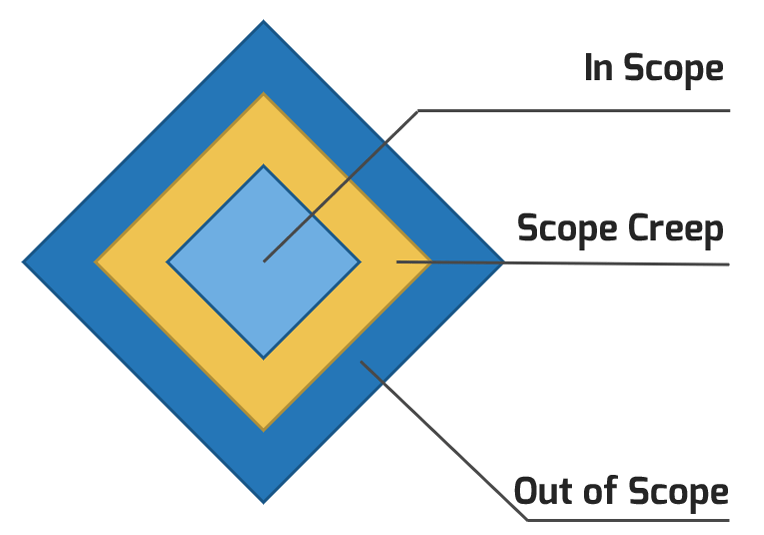
Establishing the parameters of the project in a scope statement helps define expectations and provides a baseline for resource allocation and planning. Future decisions about the strategic direction of ERP will be based on the scope statement.
Well-executed requirements gathering will help you avoid expanding project parameters, drawing on your resources, and contributing to cost overruns and project delays. Avoid scope creep by gathering high-level requirements that lead to the selection of category-level application solutions (e.g. HRIS, CRM, PLM etc.) rather than granular requirements that would lead to vendor application selection (e.g. SAP, Microsoft, Oracle, etc.).
Out-of-scope items should also be defined to alleviate ambiguity, reduce assumptions, and further clarify expectations for stakeholders. Out-of-scope items can be placed in a backlog for later consideration.
| In Scope | Out of Scope |
| Strategy | High-level ERP requirements, strategic direction |
| Software selection | Vendor application selection, Granular system requirements |
Activity 1.2.1 – Define scope
1 hour
- Formulate a scope statement. Decide which people, processes, and functions the ERP strategy will address. Generally, the aim of this project is to develop strategic requirements for the ERP application portfolio – not to select individual vendors.
- To assist in forming your scope statement, answer the following questions:
- What are the major coverage points?
- Who will be using the systems?
- How will different users interact with the systems?
- What are the objectives that need to be addressed?
- Where do we start?
- Where do we draw the line?
Record this information in the ERP Strategy Report Template.
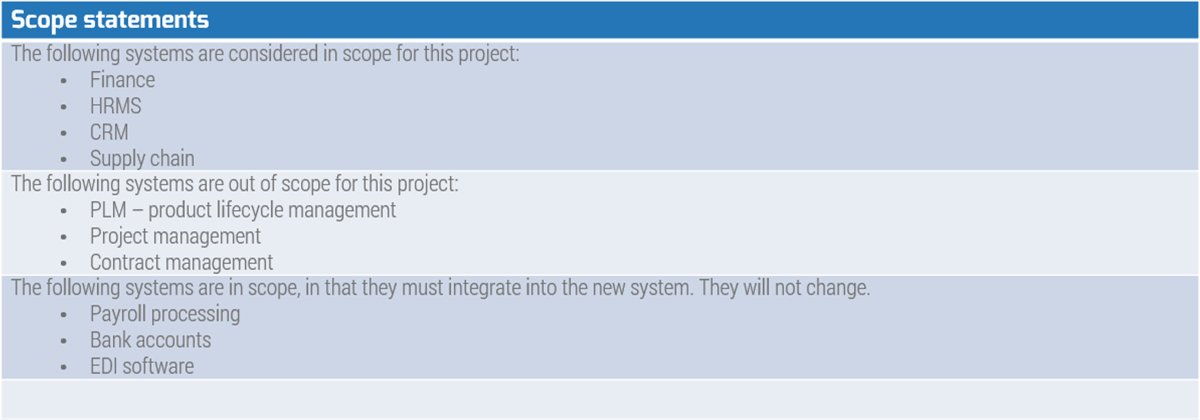
Download the ERP Strategy Report Template
Activity 1.2.1 – Define scope
Scope statements
The following systems are considered in scope for this project:
- Finance
- HRMS
- CRM
- Supply chain
The following systems are out of scope for this project:
- PLM – product lifecycle management
- Project management
- Contract management
The following systems are in scope, in that they must integrate into the new system. They will not change.
- Payroll processing
- Bank accounts
- EDI software
Know your competing priorities
Organizations typically have multiple projects on the table or in flight. Each of those projects requires resources and attention from business and/or the IT organization.
Don’t let poor prioritization hurt your ERP implementation.
BNP Paribas Fortis had multiple projects that were poorly prioritized resulting in the time to bring products to market to double over a three-year period. (Source: Neito-Rodriguez, 2016)
| Project | Timeline | Priority notes | Implications |
| Warehouse management system upgrade project | Early 2022 implementation | High | Taking IT staff and warehouse team, testing by finance |
| Microsoft 365 | October 2021-March 2022 | High | IT Staff, org impacted by change management |
| Electronic Records Management | April 2022 – Feb 2023 | High | Legislative requirement, org impact due to record keeping |
| Web site upgrade | Early fiscal 2023 |
Activity 1.2.2 – Competing priorities
1 hour
- As a group, discuss the projects that are currently in flight as well as any known projects including such things as territory expansion or new regulation compliance.
- For each project discuss and record the following items:
- The project timeline. When does it start and how long is it expected to run?
- How important is this project to the organization? A lot of high priority projects are going to require more attention from the staff involved.
- What are the implications of this project?
- What staff will be impacted? What business users will be impacted, and what is the IT involvement?
- To what extent will the overall organization be impacted? Is it localized to a location or is it organization wide?
- Can the project be deferred?
Record this information in the ERP Strategy Report Template.
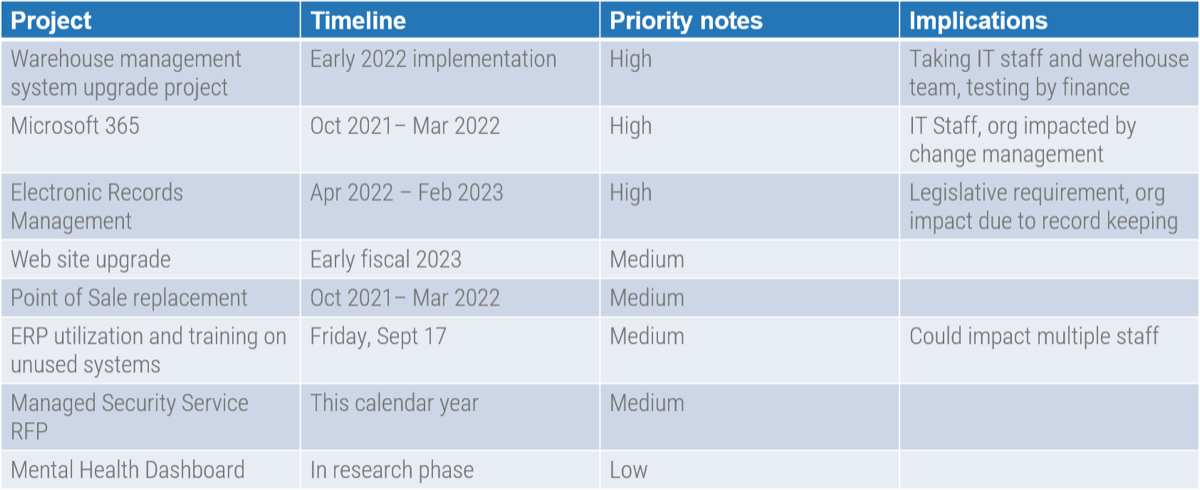
Download the ERP Strategy Report Template
Activity 1.2.2 – Competing priorities
List all your known projects both current and proposed. Discuss the prioritization of those projects, whether they are more or less important than your ERP project.
| Project | Timeline | Priority notes | Implications |
| Warehouse management system upgrade project | Early 2022 implementation | High | Taking IT staff and warehouse team, testing by finance |
| Microsoft 365 | October 2021-March 2022 | High | IT Staff, org impacted by change management |
| Electronic Records Management | April 2022 – Feb 2023 | High | Legislative requirement, org impact due to record keeping |
| Web site upgrade | Early fiscal 2023 | Medium | |
| Point of Sale replacement | Oct 2021– Mar 2022 | Medium | |
| ERP utilization and training on unused systems | Friday, Sept 17 | Medium | Could impact multiple staff |
| Managed Security Service RFP | This calendar year | Medium | |
| Mental Health Dashboard | In research phase | Low |
Build an ERP Strategy and Roadmap
Phase 2
Define your ERP
Phase 1
| Phase 2
| Phase 3
| Phase 4
|
This phase will walk you through the following activities:
- Build the ERP business model then move on to the top level (mega) processes and an initial list of the sub-processes
- Generate a list of applications that support the identified processes
- Assign stakeholders, discuss pain points, opportunities, and key success indicators
- Assign process and technology maturity to each stakeholder
This phase involves the following participants:
- Primary stakeholders in each value stream supported by the ERP
- ERP applications support team
Step 2.1
ERP business model
Activities
- 2.1.1 Environmental factors, technology drivers, and business needs
- 2.1.2 Challenges, pain points, enablers, and organizational goals
This step will walk you through the following activities:
- Identify ERP drivers and objectives
- Explore ERP challenges and pain points
- Discuss the ERP benefits and opportunities
This step involves the following participants:
- ERP implementation team
- Business stakeholders
Outcomes of this step
- ERP business model
Explore environmental factors and technology drivers
- Identify business drivers that are contributing to the organization’s need for ERP.
- Understand how the company is running today and what the organization’s future will look like. Try to identify the purpose for becoming an integrated organization.
- Consider external considerations, organizational drivers, technology drivers, and key functional requirements
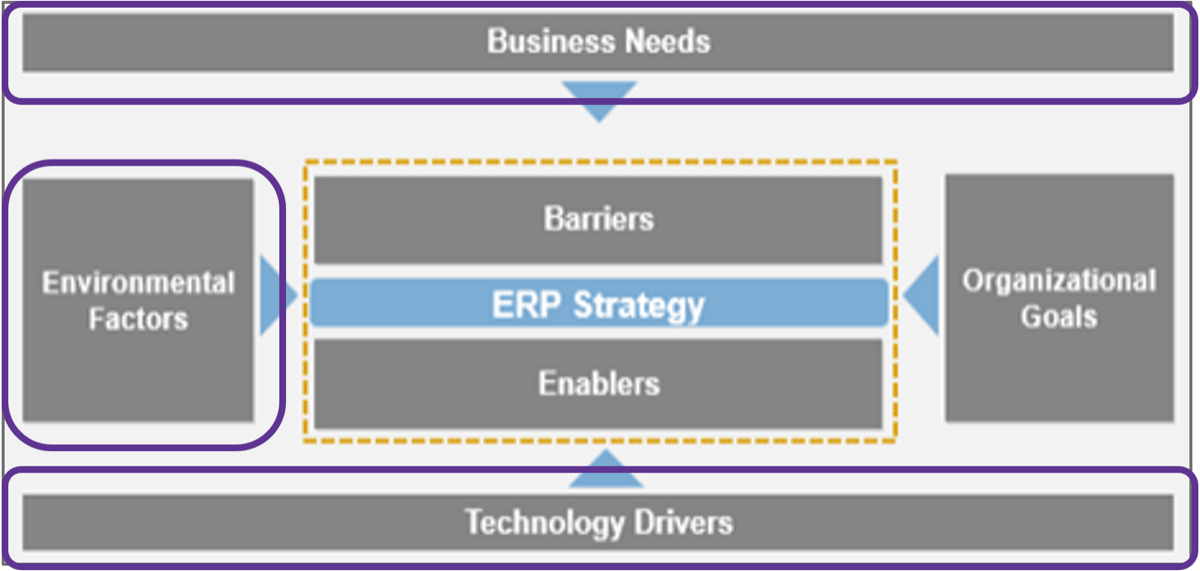
|
|||
External Considerations
|
Organizational Drivers
|
Technology Considerations
|
Functional Requirements
|
Activity 2.1.1 – Explore environmental factors and technology drivers
1 hour
- Identify business drivers that are contributing to the organization’s need for ERP.
- Understand how the company is running today and what the organization’s future will look like. Try to identify the purpose for becoming an integrated organization. Use a whiteboard or flip charts and markers to capture key findings.
- Consider External Considerations, Organizational Drivers, Technology Drivers, and Key Functional Requirements.
Record this information in the ERP Strategy Report Template.
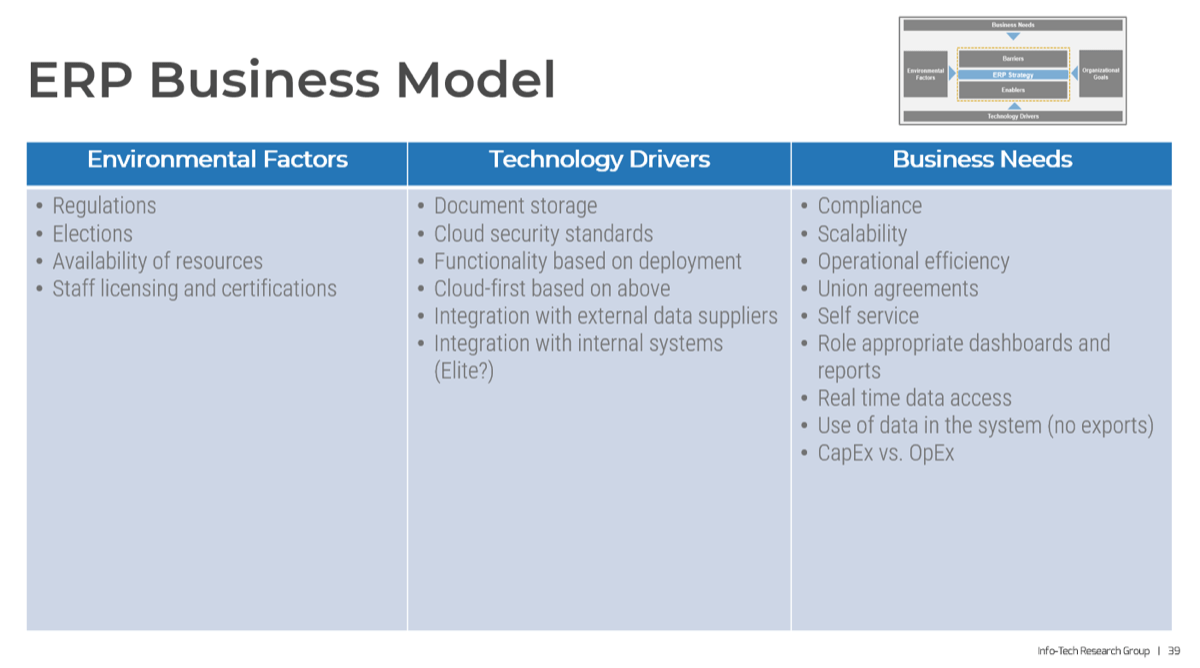
Download the ERP Strategy Report Template
ERP Business Model 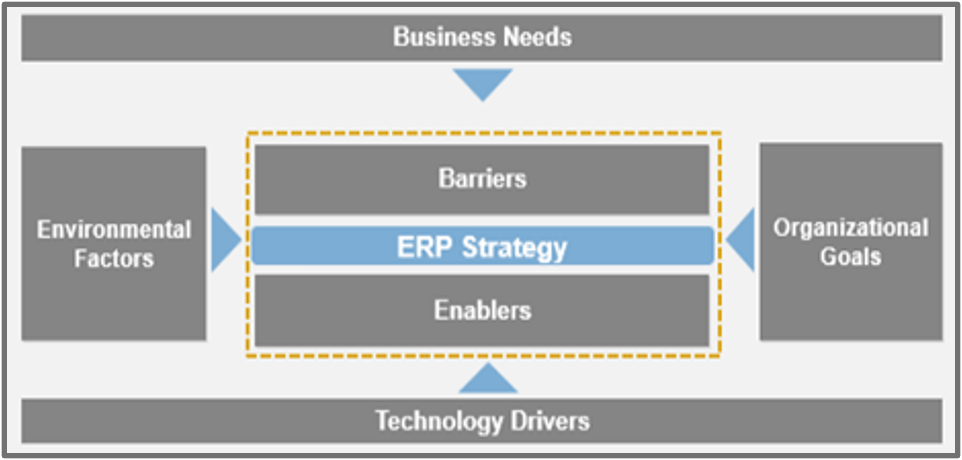
| Environmental Factors | Technology Drivers | Business Needs |
|
|
|
Discuss challenges, pain points, enablers and organizational goals
- Identify challenges with current systems and processes.
- Brainstorm potential barriers to successful ERP selection and implementation. Use a whiteboard and marker to capture key findings.
- Consider organizational goals along with barriers and enablers to ERP success.
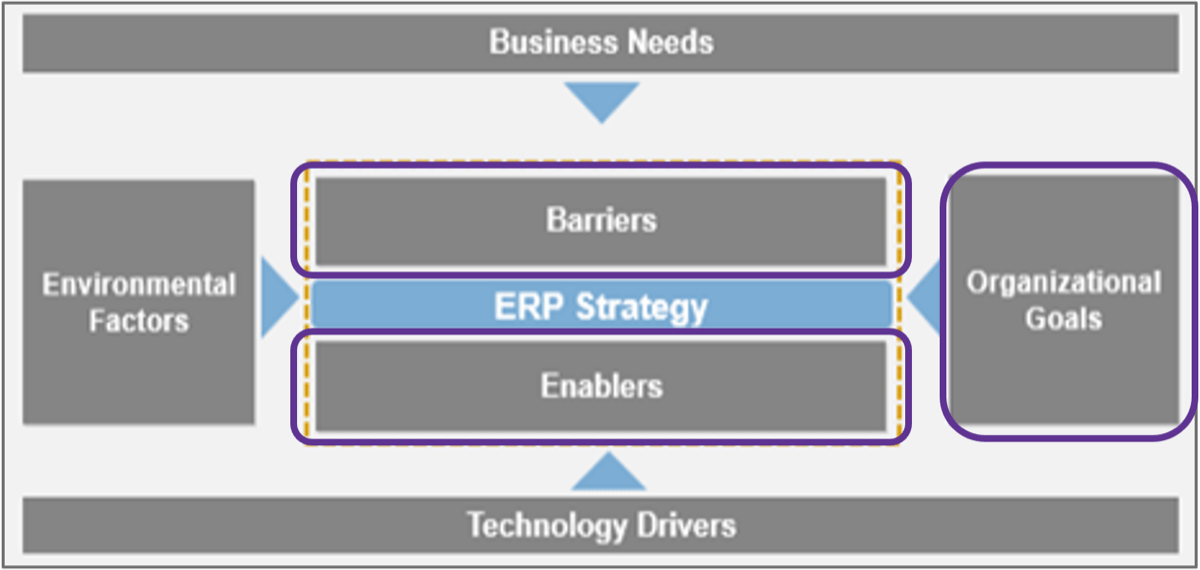
|
|||
Functional Gaps
|
Technical Gaps
|
Process Gaps
|
Barriers to Success
|
Business Benefits
|
IT Benefits
|
Organizational Benefits
|
Enablers of Success
|
Activity 2.1.2 – Discuss challenges, pain points, enablers, and organizational goals
1 hour
- Identify challenges with the current systems and processes.
- Brainstorm potential barriers to successful ERP selection and implementation. Use a whiteboard or flip chart and markers to capture key findings.
- Consider functional gaps, technical gaps, process gaps, and barriers to ERP success.
- Identify the opportunities and benefits from an integrated system.
- Brainstorm potential enablers for successful ERP selection and implementation. Use a whiteboard and markers to capture key findings.
- Consider business benefits, IT benefits, organizational benefits, and enablers of success.
Record this information in the ERP Strategy Report Template.
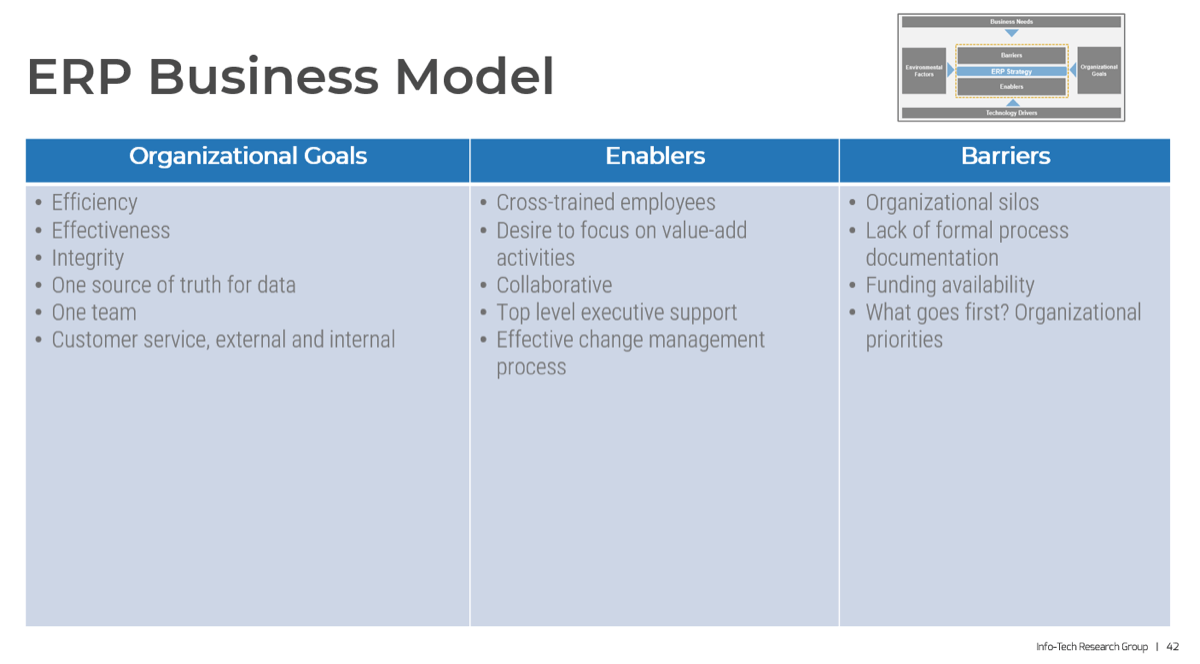
Download the ERP Strategy Report Template
ERP Business Model 
| Organizational Goals | Enablers | Barriers |
|
|
|
Step 2.2
ERP processes and supporting applications
Activities
- 2.2.1 ERP process inventory
- 2.2.2 Application portfolio
This step will walk you through the following activities:
- Identify the top-level (mega) processes and create an initial list of the sub-processes
- Generate a list of applications that support the identified processes
This step involves the following participants:
- Primary stakeholders in each value stream supported by the ERP
- ERP applications support team
Outcomes of this step
- A list of in scope business processes
- A list of current applications and services supporting the business processes
Process Inventory
In business architecture, the primary view of an organization is known as a business capability map.
A business capability defines what a business does to enable value creation rather than how.
Business capabilities:
- Represent stable business functions
- Are unique and independent of each other
- Will typically have a defined business outcome
A business capability map provides details that help the business architecture practitioner direct attention to a specific area of the business for further assessment.
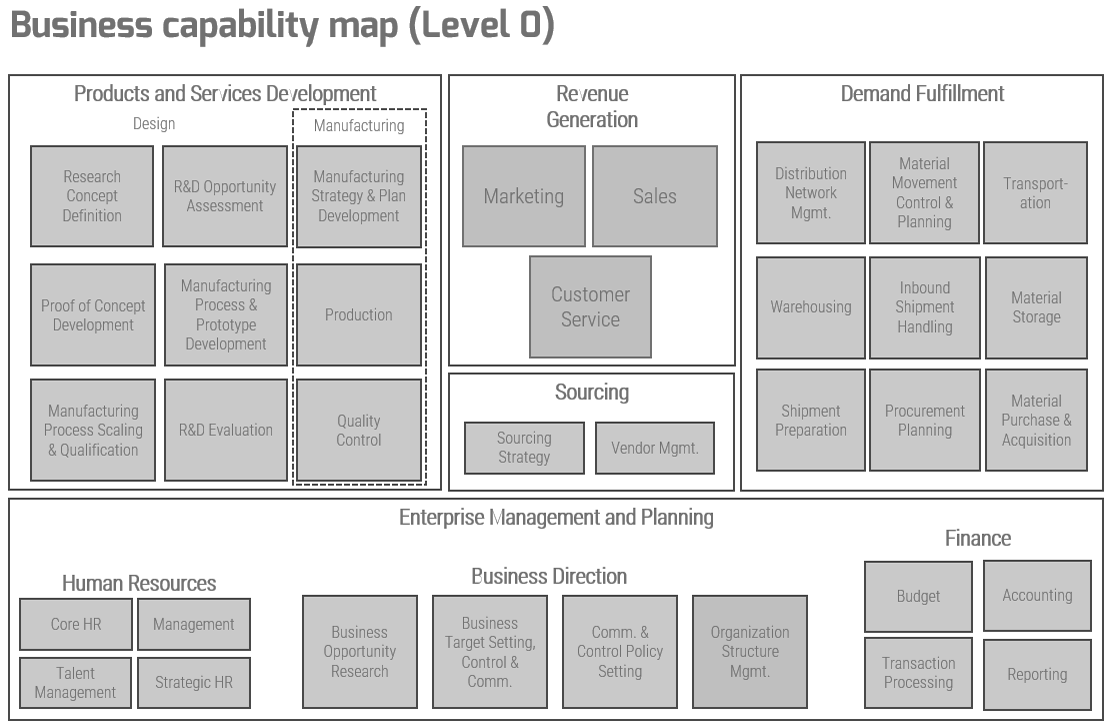
If you do not have a documented process model, you can use the APQC Framework to help define your inventory of business processes.
APQC’s Process Classification Framework is a taxonomy of cross-functional business processes intended to allow the objective comparison of organizational performance within and among organizations.
APQC’s Process Classification Framework
Activity 2.2.1 – Process inventory
2-4 hours
- As a group, discuss the business capabilities, value streams, and business processes.
- For each capability determine the following:
- Is this capability applicable to our organization?
- What application, if any, supports this capability?
- Are there any missing capabilities to add?
Record this information in the ERP Strategy Report Template.
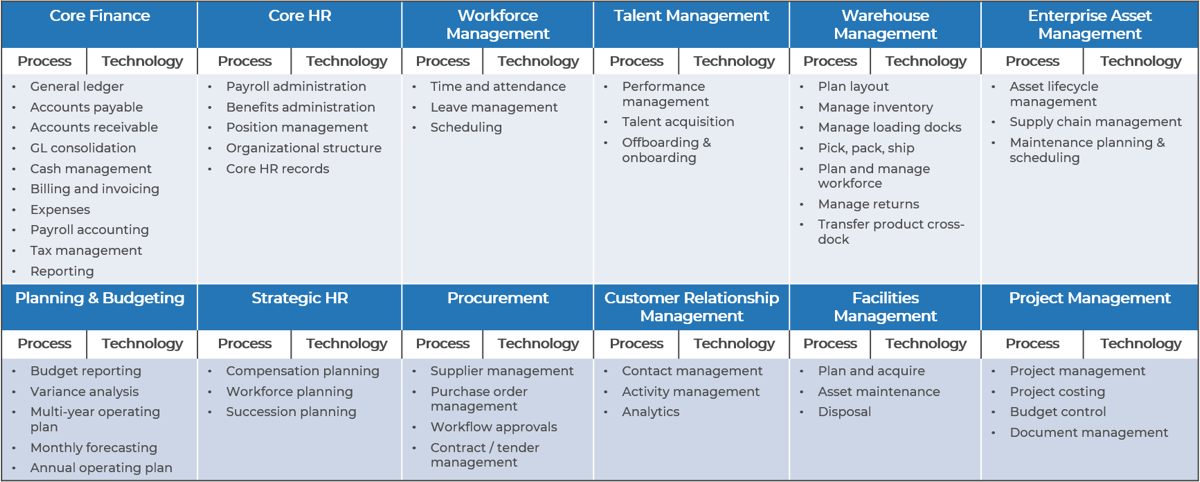
Download the ERP Strategy Report Template
Activity 2.2.1 – Process inventory
| Core Finance | Core HR | Workforce Management | Talent Management | Warehouse Management | Enterprise Asset Management | ||||||
| Process | Technology | Process | Technology | Process | Technology | Process | Technology | Process | Technology | Process | Technology |
|
|
|
|
|
|
||||||
| Planning & Budgeting | Strategic HR | Procurement | Customer Relationship Management | Facilities Management | Project Management | ||||||
| Process | Technology | Process | Technology | Process | Technology | Process | Technology | Process | Technology | Process | Technology |
|
|
|
|
|
|
||||||
Complete an inventory collection of your application portfolio
MANAGED vs. UNMANAGED APPLICATION ENVIRONMENTS
- Managed environments make way for easier inventory collection since there is significant control as to what applications can be installed on a company asset. Organizations will most likely have a comprehensive list of supported and approved applications.
- Unmanaged environments are challenging to control because users are free to install any applications on company assets, which may or may not be supported by IT.
- Most organizations fall somewhere in between – there is usually a central repository of applications and several applications that are exceptions to the company policies. Ensure that all applications are accounted for.
Determine your inventory collection method:
MANUAL INVENTORY COLLECTION
- In its simplest form, a spreadsheet is used to document your application inventory.
- For large organizations, reps interview all business domains to create a list of installed applications.
- Conducting an end-user survey within your business domains is one way to gather your application inventory and assess quality.
- This manual approach is most appropriate for smaller organizations with small application portfolios across domains.
AUTOMATED INVENTORY COLLECTION
- Using inventory collection compatibility tools, discover all of the supported applications within your organization.
- This approach may not capture all applications, depending on the parameters of your automated tool.
- This approach works well in a managed environment.
Activity 2.2.2 – Understand the current application portfolio
1-2 hours
- Brainstorm a list of the applications that support the ERP business processes inventoried in Activity 2.2.1. If an application has multiple instances, list each instance as a separate line item.
- Indicate the following for each application:
- User satisfaction. This may be more than one entry as different groups – e.g., IT vs. business – may differ.
- Processes supported. Refer to processes defined in Activity 2.2.1. Update 2.2.1 if additional processes are identified during this exercise.
- Define a future disposition: Keep, Update, Replace. It is possible to have more than one disposition, e.g., Update or Replace is a valid disposition.
- [Optional] Collect the following information about each application. This information can be used to calculate the cost per application and total cost per user:
- Number of users or user groups
- Estimated maintenance costs
- Estimated capital costs
- Estimated licensing costs
- Estimated support costs
Record this information in the ERP Strategy Report Template.
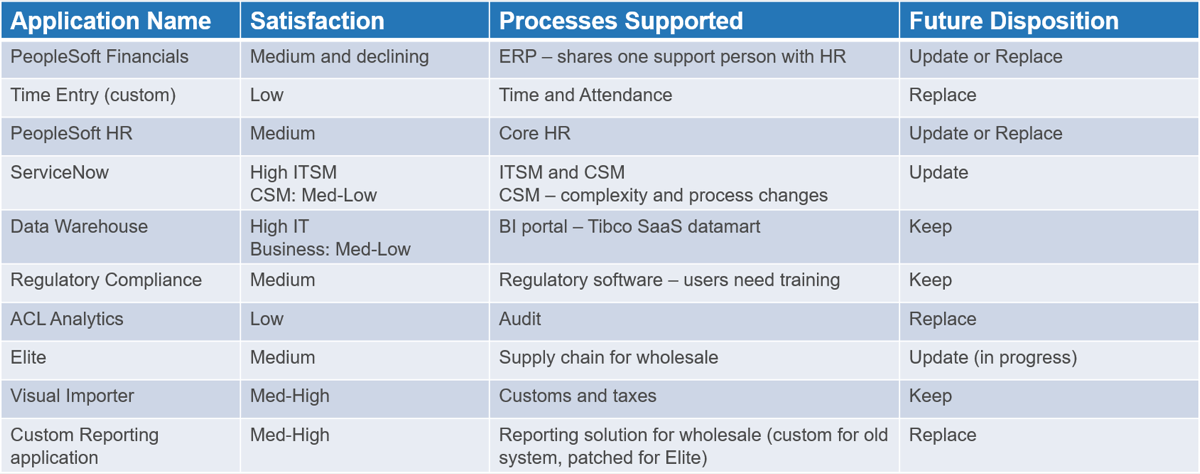
Download the ERP Strategy Report Template
2.2.2 - Application portfolio
Inventory your applications and assess usage, satisfaction, and disposition
| Application Name | Satisfaction | Processes Supported | Future Disposition |
| PeopleSoft Financials | Medium and declining | ERP – shares one support person with HR | Update or Replace |
| Time Entry (custom) | Low | Time and Attendance | Replace |
| PeopleSoft HR | Medium | Core HR | Update or Replace |
| ServiceNow | High ITSM CSM: Med-Low |
ITSM and CSM CSM – complexity and process changes |
Update |
| Data Warehouse | High IT Business: Med-Low |
BI portal – Tibco SaaS datamart | Keep |
| Regulatory Compliance | Medium | Regulatory software – users need training | Keep |
| ACL Analytics | Low | Audit | Replace |
| Elite | Medium | Supply chain for wholesale | Update (in progress) |
| Visual Importer | Med-High | Customs and taxes | Keep |
| Custom Reporting application | Med-High | Reporting solution for wholesale (custom for old system, patched for Elite) | Replace |
2.3.1 – Visual application portfolio [optional]
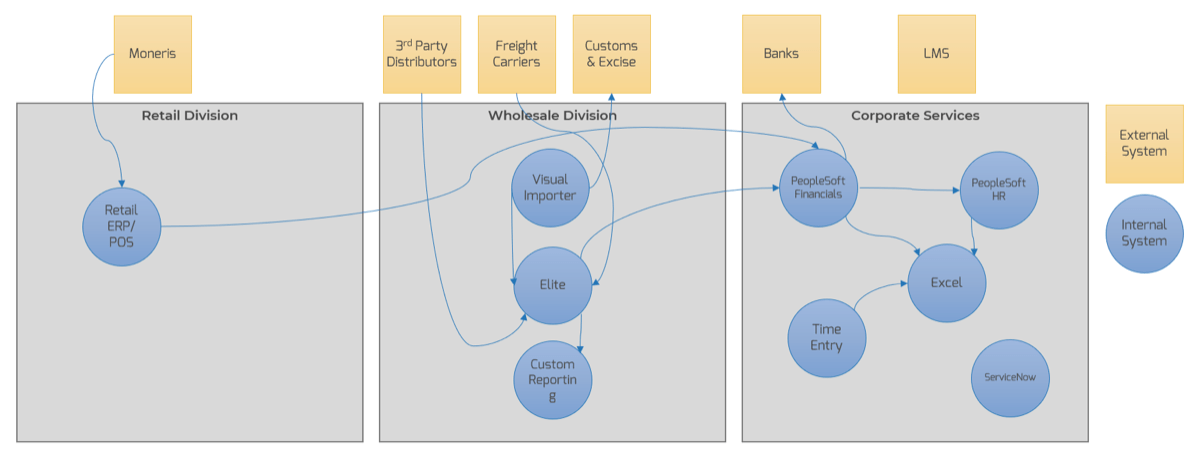
Step 2.3
Process pains, opportunities, and maturity
Activities
- 2.3.1 Level one process inventory with stakeholders
- 2.3.2 Process pain points and opportunities
- 2.3.3 Process key success indicators
- 2.3.4 Process and technology maturity
- 2.3.5 Mega-process prioritization
This step will walk you through the following activities:
- Assign stakeholders, discuss pain points, opportunities, and key success indicators for the mega-processes identified in Step 2.1
- Assign process and technology maturity to each prioritizing the mega-processes
This step involves the following participants:
- Primary stakeholders in each value stream supported by the ERP
- ERP applications support team
Outcomes of this step
For each mega-process:
- Level 1 processes with process and technology maturity assigned
- Stakeholders identified
- Process pain points, opportunities, and key success indicators identified
- Prioritize the mega-processes
Building out the mega-processes
Congratulations, you have made it to the “big lift” portion of the blueprint. For each of the processes that were identified in exercise 2.2.1, you will fill out the following six details:
- Primary stakeholder(s)
- A description of the process
- hat level 1 processes/capabilities the mega-process is composed of
- Problems the new system must solve
- What success will look like when the new system is implemented
- The process and technological maturity of each level 1 process.
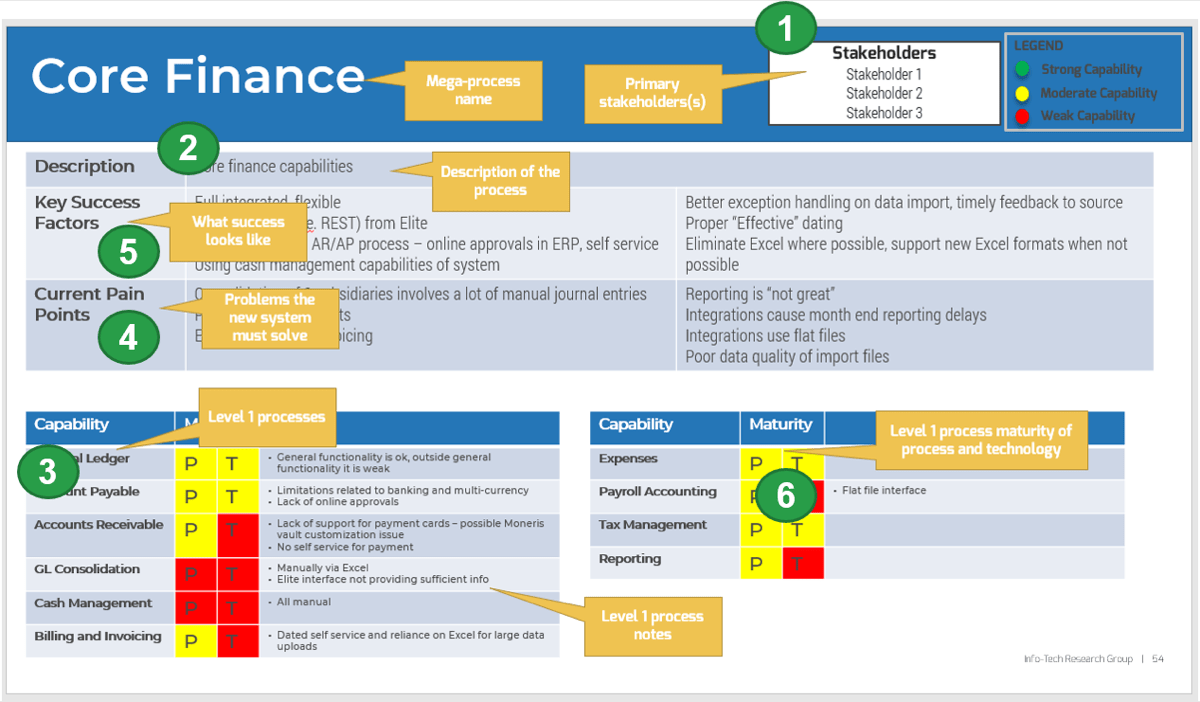
It will take one to three hours per mega-process to complete the six different sections.
Note:
For each mega-process identified you will create a separate slide in the ERP Strategy Report. Default slides have been provided. Add or delete as necessary.
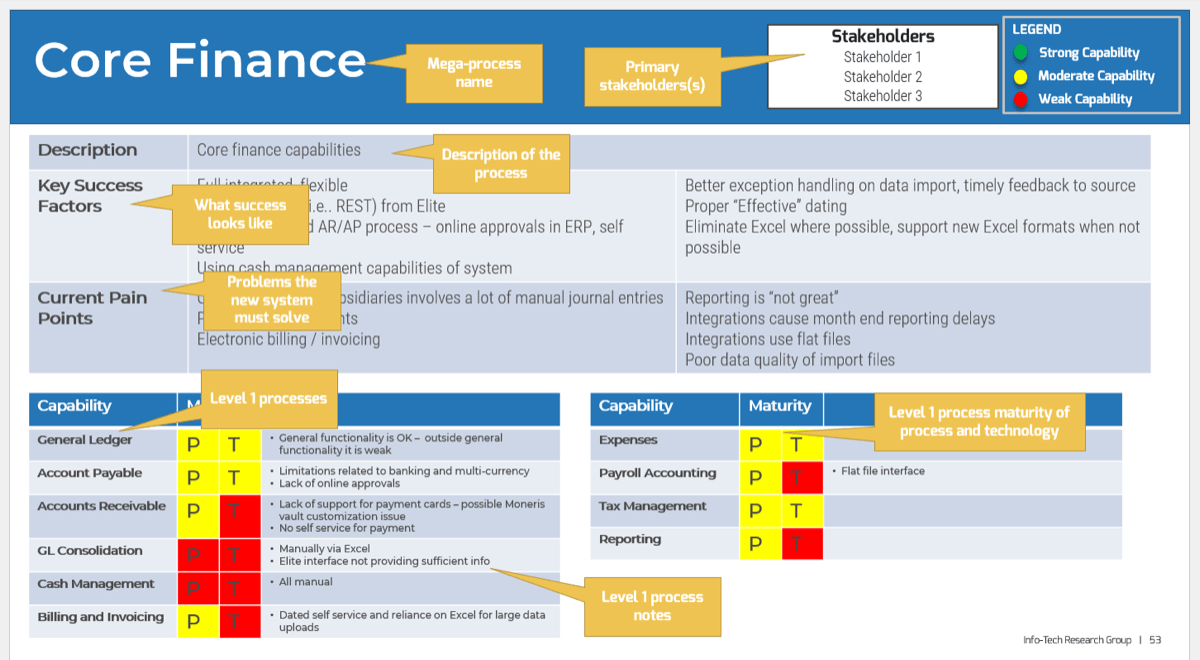
An ERP project is most effective when you follow a structured approach to define, select, implement, and optimize
Top-down approach
ERP Strategy
- Operating Model – Define process strategy, objectives, and operational implications.
- Level 1 Processes –Define process boundaries, scope at the organization level; the highest level of mega-process.
- Level 2 Processes – Define processes by function/group which represent the next level of process interaction in the organization.
- Level 3 Processes – Decompose process by activity and role and identify suppliers, inputs, outputs, customers, metrics, and controls.
- Functional Specifications; Blueprint and Technical Framework – Refine how the system will support and enable processes; includes functional and technical elements.
- Org Structure and Change Management – Align org structure and develop change mgmt. strategy to support your target operating model.
- Implementation and Transition to Operations – Execute new methods, systems, processes, procedures, and organizational structure.
- ERP Optimization and Continuous Improvement – Establish a program to monitor, govern, and improve ERP systems and processes.
*A “stage gate” approach should be used: the next level begins after consensus is achieved for the previous level.
Activity 2.3.1 – Level 1 process inventory with stakeholders
1 hour per mega-process
- Identify the primary stakeholder for the mega-process. The primary stakeholder is usually the process owner. For example, for core finance the CFO is the process owner/primary stakeholder. Name a maximum of three stakeholders.
- In the lower section, detail all the capabilities/processes associated with the mega-process. Be careful to remain at the level 1 process level as it is easy to start identifying the “How” of a process. The “How” is too deep.
Record this information in the ERP Strategy Report Template.
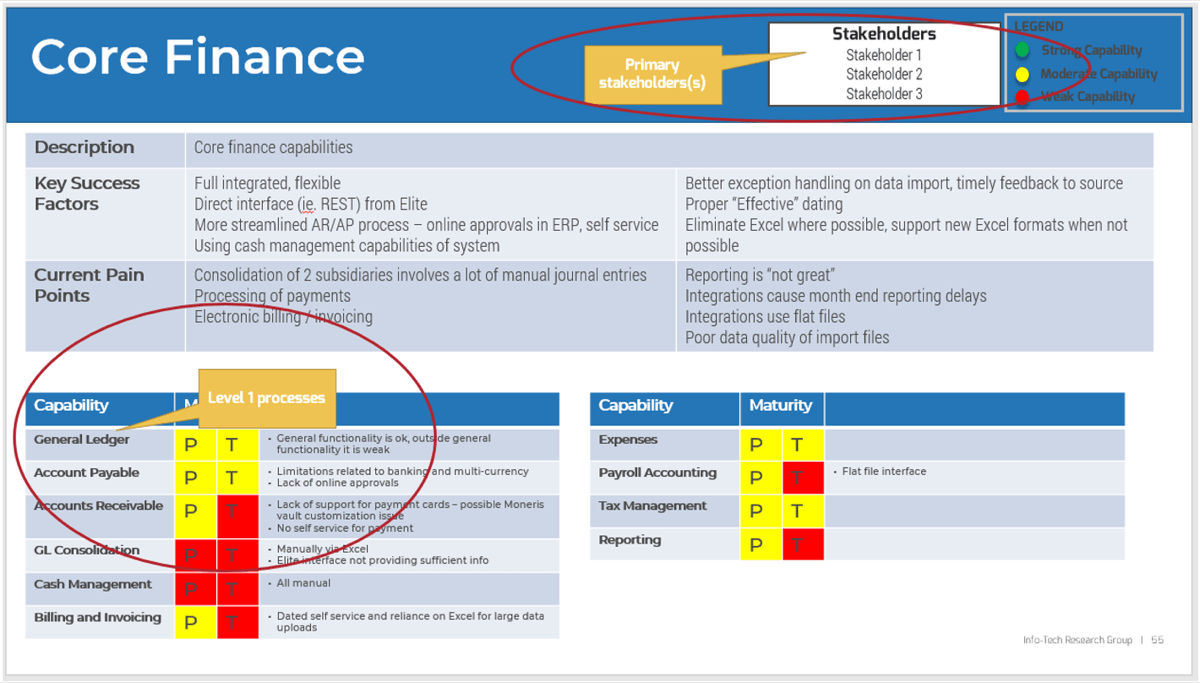
Download the ERP Strategy Report Template
Activity 2.3.2 – Process pain points and opportunities
30+ minutes per mega-process
- As a group, write a clear description of the mega-process. This helps establish alignment on the scope of the mega-process.
- Start with the discussion of current pain points with the various capabilities. These pain points will be items that the new solution will have to resolve.
Record this information in the ERP Strategy Report Template.
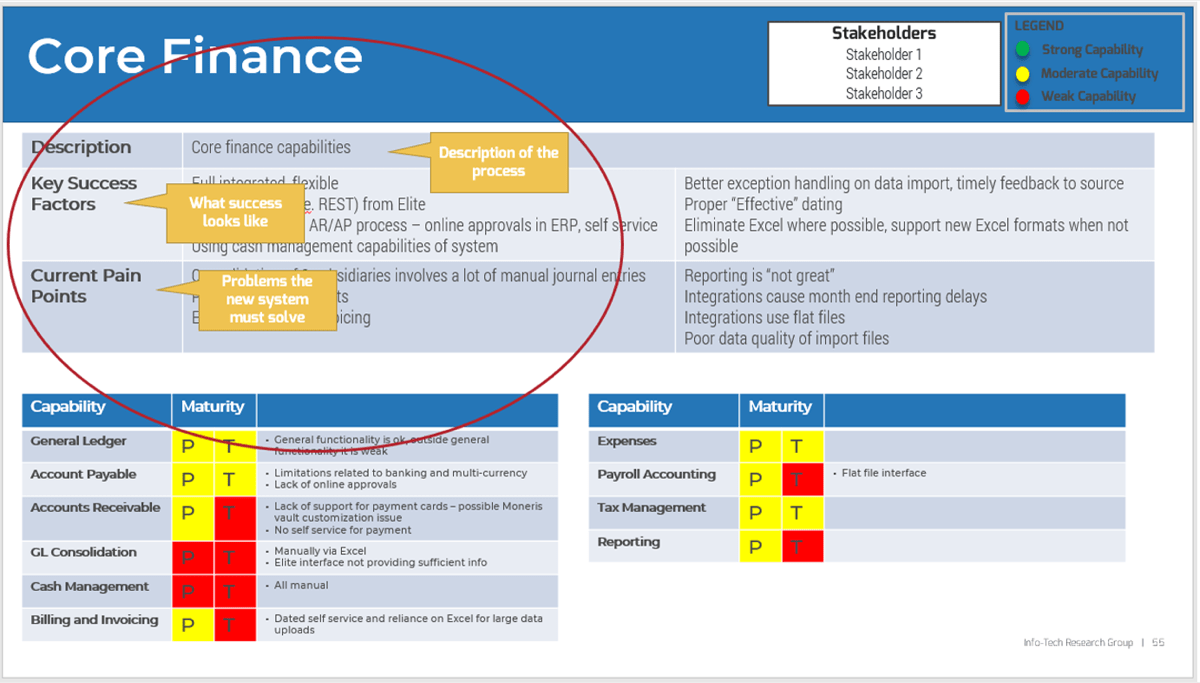
Download the ERP Strategy Report Template
Activity 2.3.3 – Key success indicators
30 minutes per mega-process
- Document key success factors that should be base-lined in the existing system to show the overall improvement once the new system is implemented. For example, if month-end close takes 12 days in the current system, target three days for month-end close in the new system.
Record this information in the ERP Strategy Report Template.

Download the ERP Strategy Report Template
Activity 2.3.4 – Process and technology maturity
1 hour
- For each capability/level 1 process identified determine you level of process maturity:
- Weak – Ad hoc processes without documentation
- Moderate – Documented processes that are often executed consistently
- Strong – Documented processes that include exception handling that are rigorously followed Payroll is an example of a strong process, even if every step is manual. The process is executed the same every time to ensure staff are paid properly and on time.
- For each capability/level 1 process identified determine you level of technology maturity:
- Weak – manual execution and often paper-based
- Moderate – Some technology support with little automation
- Strong – The process executed entirely within the technology stack with no manual processes
Record this information in the ERP Strategy Report Template.
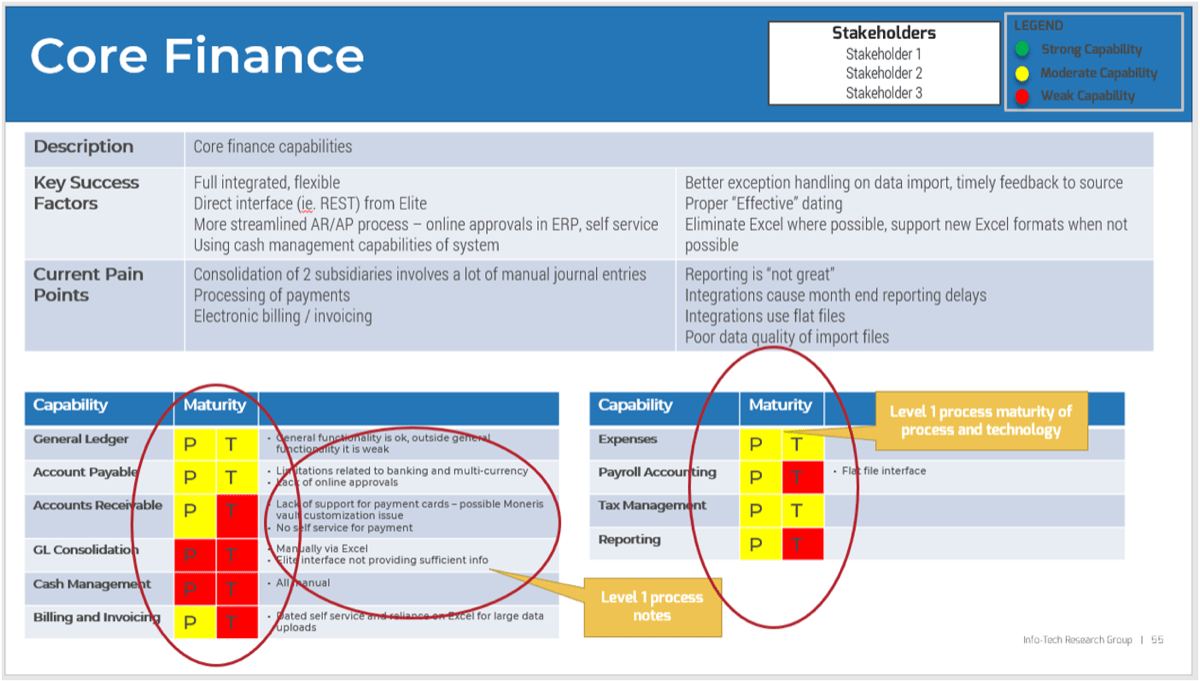
Download the ERP Strategy Report Template
Activity 2.3.5 – Mega-process prioritization
1 hour
- For the mega-processes identified, map each process’s current state in terms of process rigor versus organizational importance.
- For process rigor, refer to your process maturity in the previous exercises.
- Now, as a group discuss how you want to “move the needle” on each of the processes. Remember that you have a limited capacity so focus on the processes that are, or will be, of strategic importance to the organization. The processes that are placed in the top right quadrant are the ones that are likely the strategic differentiators.
Record this information in the ERP Strategy Report Template.
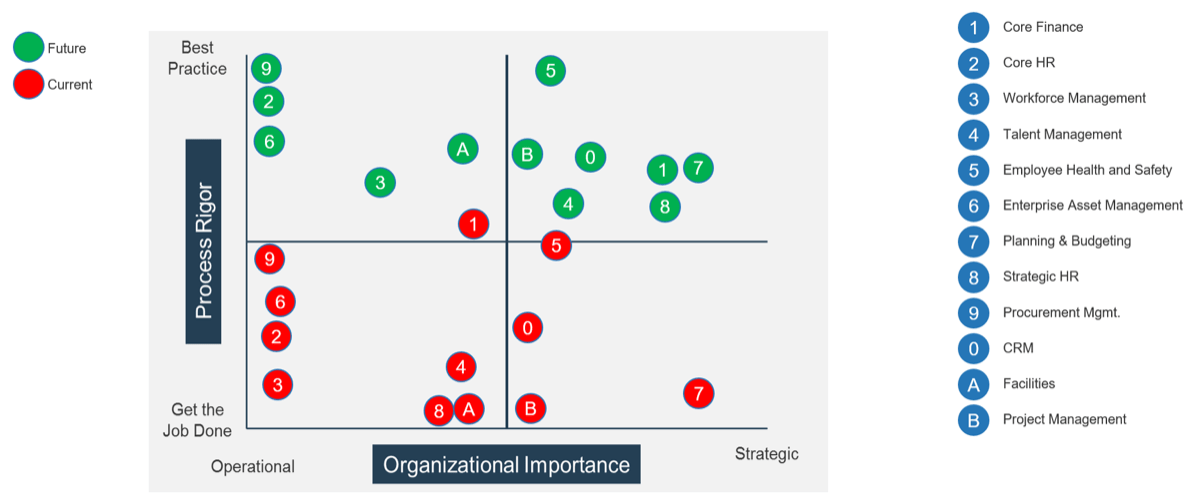
Download the ERP Strategy Report Template.
ERP Process Prioritization
Establishing an order of importance can impact vendor selection and implementation roadmap; high priority areas are critical for ERP success.

Build an ERP Strategy and Roadmap
Phase 3
Plan your project
Phase 1
| Phase 2
| Phase 3
| Phase 4
|
This phase will walk you through the following activities:
- Map out your stakeholders to evaluate their impact on the project
- Build an initial risk register and ensure the group is aligned
- Set the initial core project team and their accountabilities and get them started on the project
This phase involves the following participants:
- Primary stakeholders in each value stream supported by the ERP
- ERP Applications support team
Step 3.1
Stakeholders, risk, and value
Activities
- 3.1.1 Stakeholder analysis
- 3.1.2 Potential pitfalls and mitigation strategies
- 3.1.3 Project value [optional]
This step will walk you through the following activities:
- Map out your stakeholders to evaluate their impact on the project
- Build an initial risk register and ensure the group is aligned
This step involves the following participants:
- Primary stakeholders in each value stream supported by the ERP
- ERP Applications support team
Outcomes of this step
- An understanding of the stakeholders and their project influence
- An initial risk register
- A consensus on readiness to proceed
Understand how to navigate the complex web of stakeholders in ERP
Identify which stakeholders to include and what their level of involvement should be during requirements elicitation based on relevant topic expertise.
| Sponsor | End User | IT | Business | |
| Description | An internal stakeholder who has final sign-off on the ERP project. | Front-line users of the ERP technology. | Back-end support staff who are tasked with project planning, execution, and eventual system maintenance. | Additional stakeholders that will be impacted by any ERP technology changes. |
| Examples |
|
|
|
|
| Value | Executive buy-in and support is essential to the success of the project. Often, the sponsor controls funding and resource allocation. | End users determine the success of the system through user adoption. If the end user does not adopt the system, the system is deemed useless and benefits realization is poor. | IT is likely to be responsible for more in-depth requirements gathering. IT possesses critical knowledge around system compatibility, integration, and data. | Involving business stakeholders in the requirements gathering will ensure alignment between HR and organizational objectives. |
Large-scale ERP projects require the involvement of many stakeholders from all corners and levels of the organization, including project sponsors, IT, end users, and business stakeholders. Consider the influence and interest of stakeholders in contributing to the requirements elicitation process and involve them accordingly.
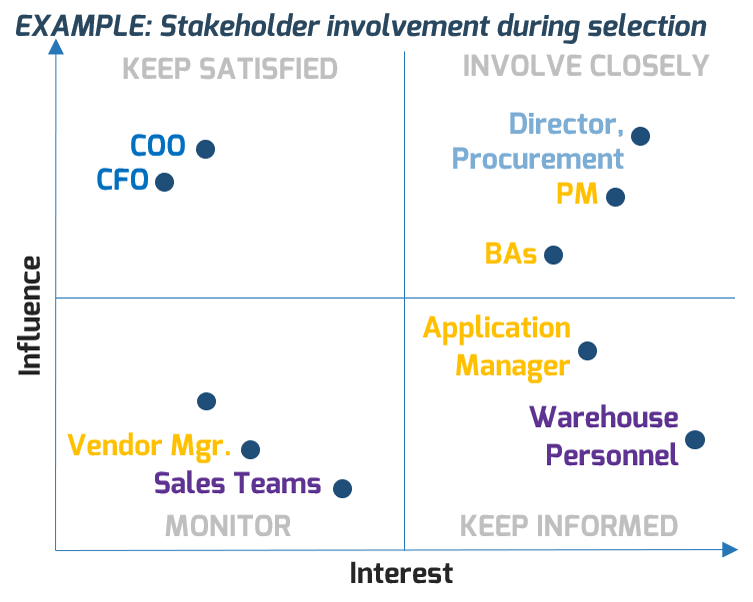
Activity 3.1.1 – Map your stakeholders
1 hour
- As a group, identify all the ERP stakeholders. A stakeholder may be an individual such as the CEO or CFO, or it may be a group such as front-line employees.
- Map each stakeholder on the quadrant based on their expected Influence and Involvement in the project
- [Optional] Color code the users using the scale below to quickly identify the group that the stakeholder belongs to.
- Sponsor – An internal stakeholder who has final sign-off on the ERP project.
- End User – Front-line users of the ERP technology.
- IT – Back-end support staff who are tasked with project planning, execution, and eventual system maintenance.
- Business – Additional stakeholders that will be impacted by any ERP technology changes.
Record this information in the ERP Strategy Report Template.
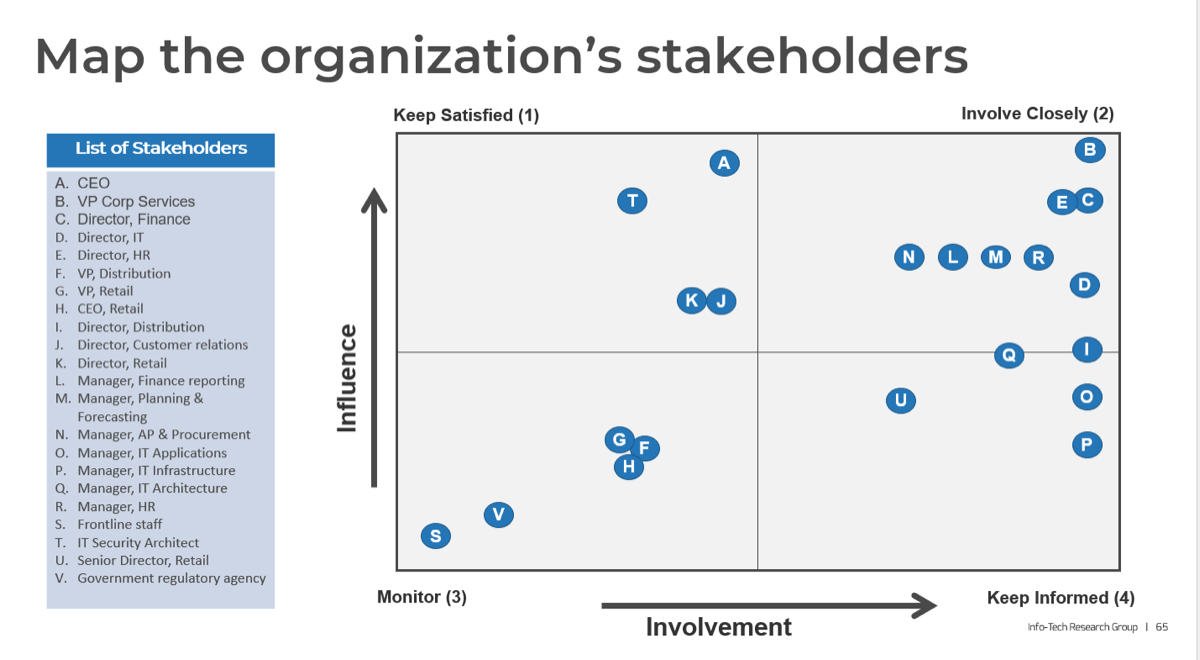
Download the ERP Strategy Report Template

Prepare contingency plans to minimize time spent handling unexpected risks
Understanding the technical and strategic risks of a project can help you establish contingencies to reduce the likelihood of risk occurrence and devise mitigation strategies to help offset their impact if contingencies are insufficient.
| Risk | Impact | Likelihood | Mitigation Effort |
| Inadequate budget for additional staffing resources. | 2 | 1 | Use internal transfers and role-sharing rather than external hiring. |
| Push-back on an ERP solution. | 2 | 2 | Use formal communication plans, an ERP steering committee, and change management to overcome organizational readiness. |
| Overworked resources. | 1 | 1 | Create a detailed project plan that outlines resources and timelines in advance. |
Rating Scale: |
|||
| Impact: | 1- High Risk | 2- Moderate Risk | 3- Minimal Risk |
| Likelihood: | 1- High/Needs Focus | 2- Can Be Mitigated | 3- Remote Likelihood |
Remember
The biggest sources of risk in an ERP strategy are lack of planning, poorly defined requirements, and lack of governance.
Apply the following mitigation tips to avoid pitfalls and delays.
Risk Mitigation Tips
- Upfront planning
- Realistic timelines
- Resource support
- Managing change
- Executive sponsorship
- Sufficient funding
- Setting the right expectations
Activity 3.1.2 – Identify potential project pitfalls and mitigation strategies
1-2 hours
- Discuss what “Impact” and “Likelihood” mean to your organization. For example, define Impact by what is important to your organization – financial loss, reputational impact, employee loss, and process impairment are all possible factors.
- Identify potential risks that may impede the successful completion of each work initiative. Risks may include predictable factors such as low resource capability, or unpredictable factors such as a change in priorities leading to withdrawn buy-in.
- For each risk, identify mitigation tactics. In some cases, mitigation tactics might take the form of standalone work initiative. For example, if a risk is lack of end-user buy-in, a work initiative to mitigate that risk might be to build an end-user communication plan.
Record this information in the ERP Strategy Report Template.
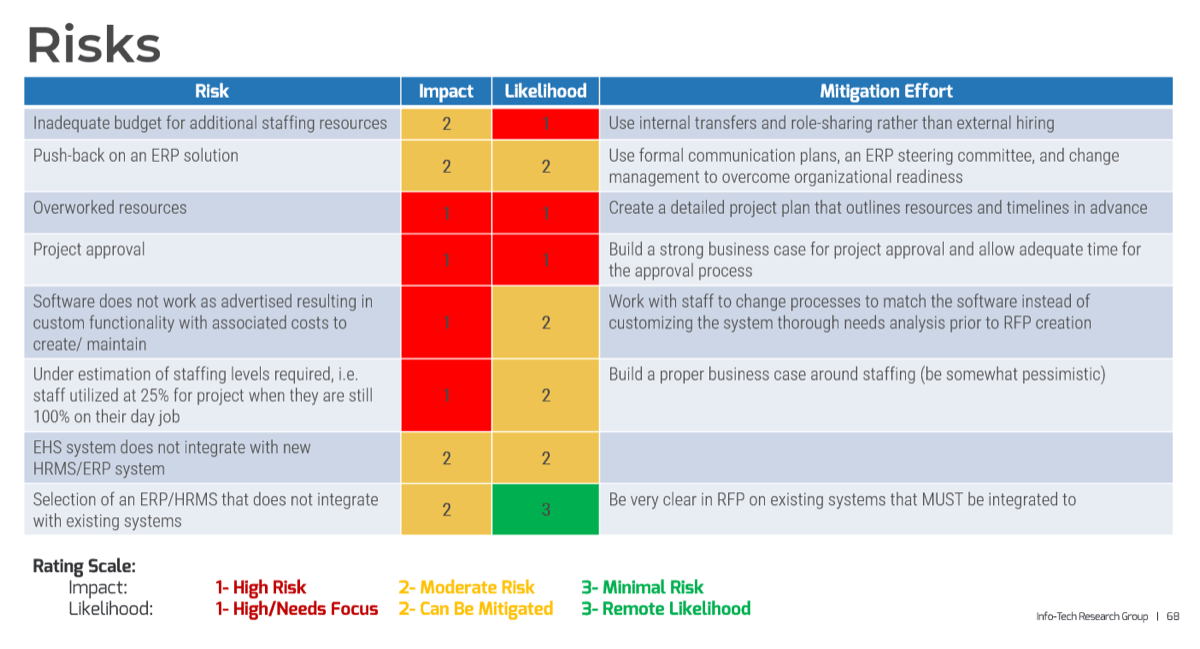
Download the ERP Strategy Report Template
Risks
| Risk | Impact | Likelihood | Mitigation Effort |
| Inadequate budget for additional staffing resources. | 2 | 1 | Use internal transfers and role-sharing rather than external hiring. |
| Push-back on an ERP solution. | 2 | 2 | Use formal communication plans, an ERP steering committee, and change management to overcome organizational readiness. |
| Overworked resources. | 1 | 1 | Create a detailed project plan that outlines resources and timelines in advance. |
| Project approval | 1 | 1 | Build a strong business case for project approval and allow adequate time for the approval process |
| Software does not work as advertised resulting in custom functionality with associated costs to create/ maintain | 1 | 2 | Work with staff to change processes to match the software instead of customizing the system thorough needs analysis prior to RFP creation |
| Under estimation of staffing levels required, i.e. staff utilized at 25% for project when they are still 100% on their day job | 1 | 2 | Build a proper business case around staffing (be somewhat pessimistic) |
| EHS system does not integrate with new HRMS/ERP system | 2 | 2 | |
| Selection of an ERP/HRMS that does not integrate with existing systems | 2 | 3 | Be very clear in RFP on existing systems that MUST be integrated to |
Rating Scale: |
|||
| Impact: | 1- High Risk | 2- Moderate Risk | 3- Minimal Risk |
| Likelihood: | 1- High/Needs Focus | 2- Can Be Mitigated | 3- Remote Likelihood |
Is the organization committed to the ERP project?
A recent study of critical success factors to an ERP implementation identified top management support and interdepartmental communication and cooperation as the top two success factors.
By answering the seven questions the key stakeholders are indicating their commitment. While this doesn’t guarantee that the top two critical success factors have been met, it does create the conversation to guide the organization into alignment on whether to proceed.
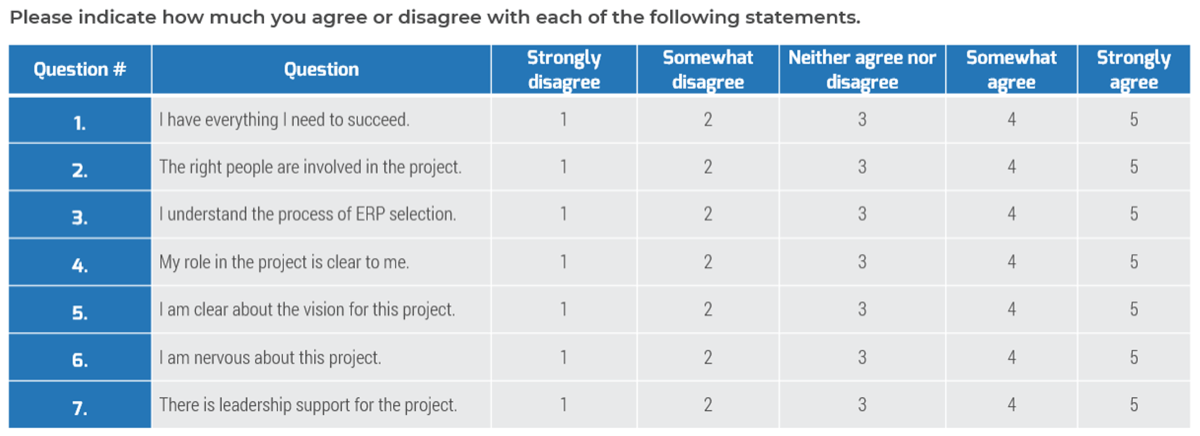
Activity 3.1.3 – Project value (optional)
30 minutes
- As a group, discuss the seven questions in the table. Ensure everyone agrees on what the questions are asking. If necessary, modify the language so that the meaning is clear to everyone.
- Have each stakeholder answer the seven questions on their own. Have someone compile the answers looking for:
- Any disagrees, strongly, somewhat, or neither as this indicates a lack of clarity. Endeavour to discover what additional information is required.
- [Optional] Have the most positive and most negative respondents present their points of view for the group to discuss. Is someone being overly optimistic, or pessimistic? Did the group miss something?
There are no wrong answers. It should be okay to disagree with any of these statements. The goal of the exercise is to generate conversation that leads to support of the project and collaboration on the part of the participants.
Record this information in the ERP Strategy Report Template.
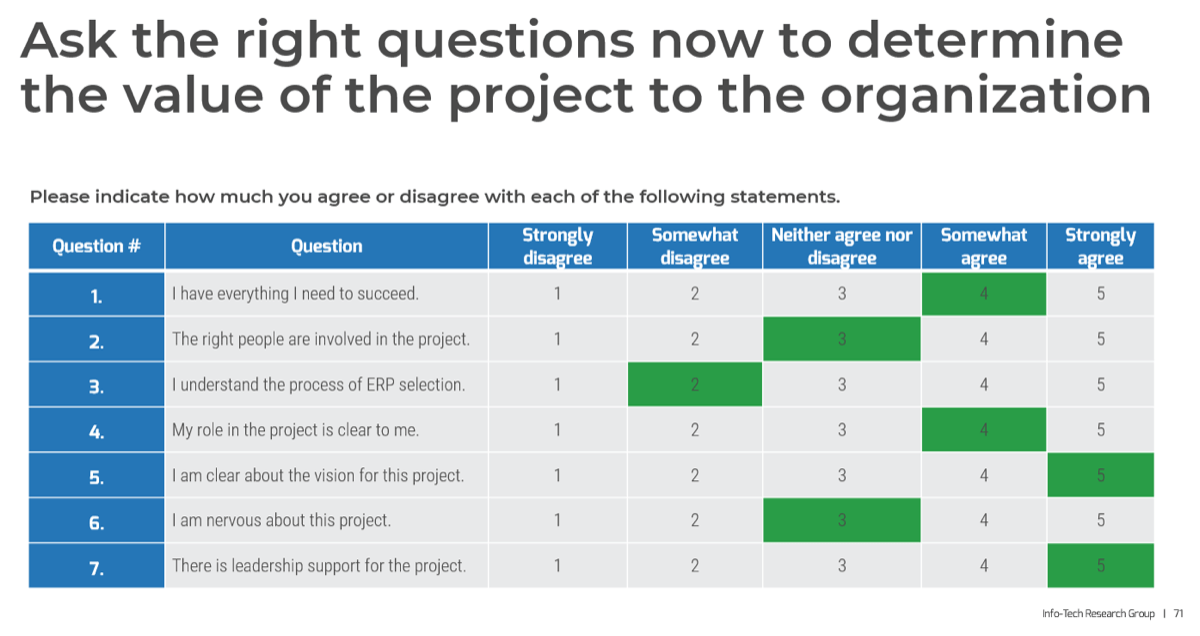
Download the ERP Strategy Report Template
Ask the right questions now to determine the value of the project to the organization
Please indicate how much you agree or disagree with each of the following statements.
| Question # | Question | Strongly disagree | Somewhat disagree | Neither agree nor disagree | Somewhat agree | Strongly agree |
| 1. | I have everything I need to succeed. | 1 | 2 | 3 | 4 | 5 |
| 2. | The right people are involved in the project. | 1 | 2 | 3 | 4 | 5 |
| 3. | I understand the process of ERP selection. | 1 | 2 | 3 | 4 | 5 |
| 4. | My role in the project is clear to me. | 1 | 2 | 3 | 4 | 5 |
| 5. | I am clear about the vision for this project. | 1 | 2 | 3 | 4 | 5 |
| 6. | I am nervous about this project. | 1 | 2 | 3 | 4 | 5 |
| 7. | There is leadership support for the project. | 1 | 2 | 3 | 4 | 5 |
Step 3.2
Project set up
Activities
- 3.2.1 Create the project team
- 3.2.2 Set the project RACI
This step will walk you through the following activities:
- Set the initial core project team and their accountabilities to the project.
This step involves the following participants:
- Primary stakeholders in each value stream supported by the ERP
- ERP Applications support team
Outcomes of this step
- Identify the core team members and their time commitments.
- Assign responsibility, accountability or communication needs.
Identify the right stakeholders for your project team
Consider the core team functions when composing the project team. It is essential to ensure that all relevant perspectives (business, IT, etc.) are evaluated to create a well-aligned and holistic ERP strategy.
PROJECT TEAM ROLES
- Project champion
- Project advisor
- Steering committee
- Project manager
- Project team
- Subject matter experts
- Change management specialist
PROJECT TEAM FUNCTIONS
- Collecting all relevant inputs from the business.
- Gathering high-level requirements.
- Creating a roadmap.
Info-Tech Insight
There may be an inclination towards a large project team when trying to include all relevant stakeholders. Carefully limiting the size of the project team will enable effective decision making while still including functional business units like HR and Finance, as well as IT.
Activity 3.2.1 – Project team
1 hour
- Considering your ERP project scope, discuss the resources and capabilities necessary, and generate a complete list of key stakeholders considering each of the roles indicated on the chart to the right.
- Using the list previously generated, identify a candidate(s) for each role and determine their responsibility in the ERP strategy and their expected time commitment.
Record this information in the ERP Strategy Report Template.
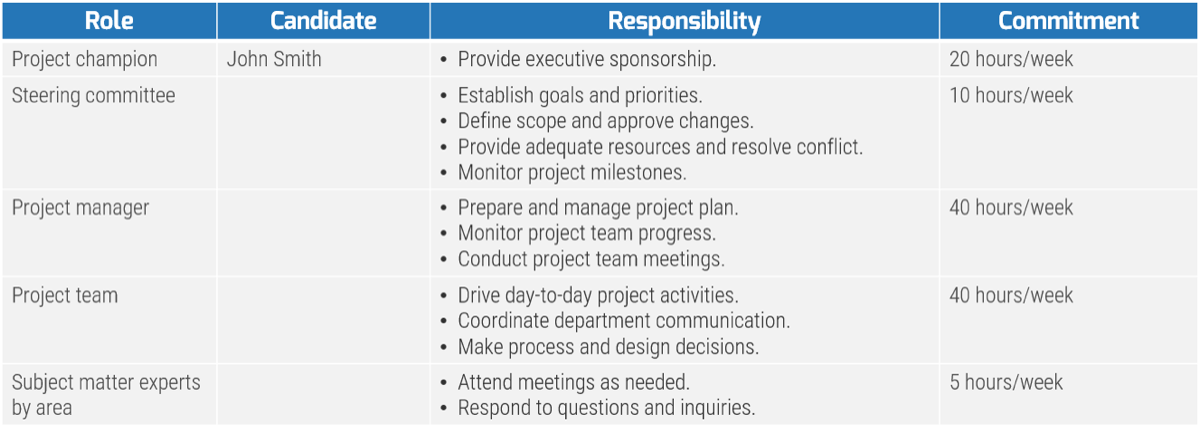
Download the ERP Strategy Report Template
Project team
Of particular importance for this table is the commitment column. It is important that the organization understands the level of involvement for all roles. Failure to properly account for the necessary involvement is a major risk factor.
| Role | Candidate | Responsibility | Commitment |
| Project champion | John Smith |
|
20 hours/week |
| Steering committee |
|
10 hours/week | |
| Project manager |
|
40 hours/week | |
| Project team |
|
40 hours/week | |
| Subject matter experts by area |
|
5 hours/week |
Define project roles and responsibilities to improve progress tracking
Build a list of the core ERP strategy team members and then structure a RACI chart with the relevant categories and roles for the overall project.
- Responsible – Conducts work to achieve the task
- Accountable – Answerable for completeness of task
- Consulted – Provides input for the task
- Informed – Receives updates on the task
Benefits of assigning RACI early:
- Improve project quality by assigning the right people to the right tasks.
- Improve chances of project task completion by assigning clear accountabilities.
- Improve project buy-in by ensuring stakeholders are kept informed of project progress, risks, and successes.
Activity 3.2.2 – Project RACI
1 hour
- The ERP strategy will require a cross-functional team within IT and business units. Make sure the responsibilities are clearly communicated to the selected project sponsor.
- Modify the left-hand column to match the activities expected in your project.
Record this information in the ERP Strategy Report Template.
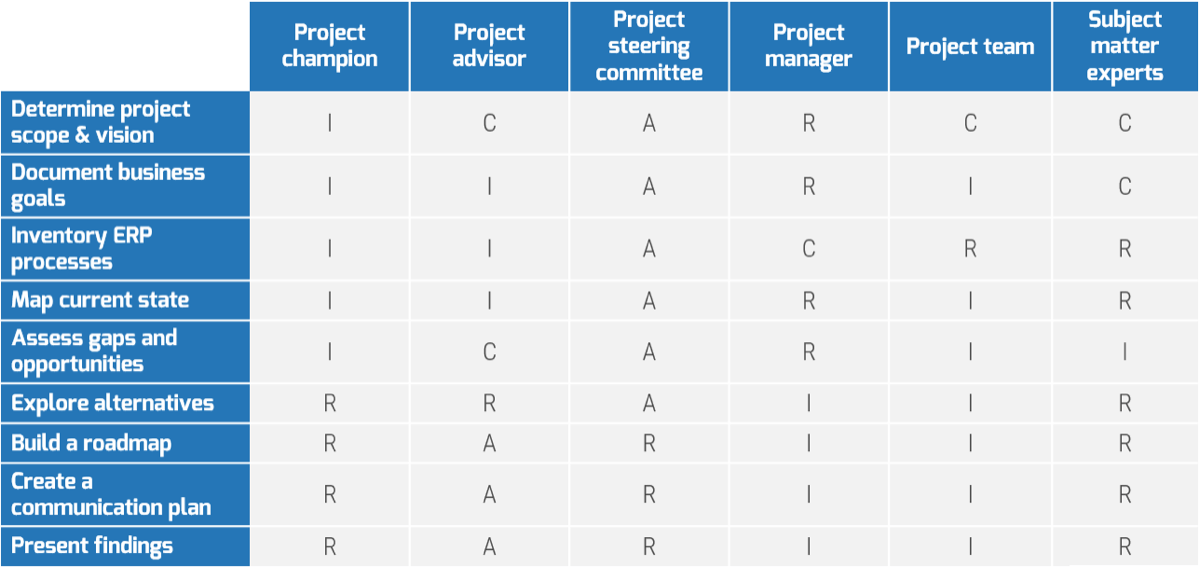
Download the ERP Strategy Report Template
3.2.2 – Project RACI
| Project champion | Project advisor | Project steering committee | Project manager | Project team | Subject matter experts | |
| Determine project scope & vision | I | C | A | R | C | C |
| Document business goals | I | I | A | R | I | C |
| Inventory ERP processes | I | I | A | C | R | R |
| Map current state | I | I | A | R | I | R |
| Assess gaps and opportunities | I | C | A | R | I | I |
| Explore alternatives | R | R | A | I | I | R |
| Build a roadmap | R | A | R | I | I | R |
| Create a communication plan | R | A | R | I | I | R |
| Present findings | R | A | R | I | I | R |
Build an ERP Strategy and Roadmap
Phase 4
Next steps
Phase 1
| Phase 2
| Phase 3
| Phase 4
|
This phase will walk you through the following activities:
- Review the different options to solve the identified pain points
- Build out a roadmap showing how you will get to those solutions
- Build a communication plan that includes the stakeholder presentation
This phase involves the following participants:
- Primary stakeholders in each value stream supported by the ERP
- ERP Applications support team
Step 4.1
Build your roadmap
Activities
- 4.1.1 Pick your path
- 4.1.2 Build your roadmap
- 4.1.3 Visualize your roadmap (optional)
This step will walk you through the following activities:
- Review the different options to solve the identified pain points then build out a roadmap of how to get to that solution.
This step involves the following participants:
- Primary stakeholders in each value stream supported by the ERP
- ERP Applications support team
Outcomes of this step
- A strategic direction is set
- An initial roadmap is laid out
Choose the right path for your organization
There are several different paths you can take to achieve your ideal future state. Make sure to pick the one that suits your needs as defined by your current state.
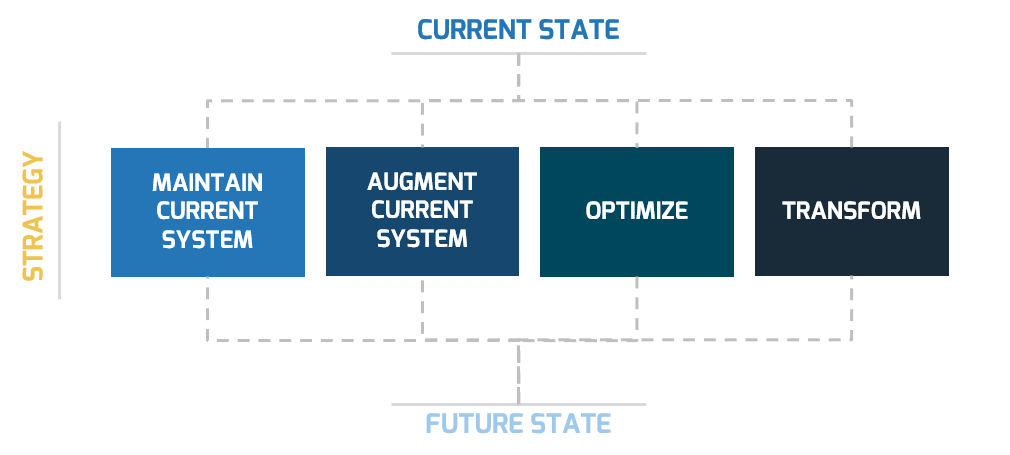
Explore the options for achieving your ideal future state
| CURRENT STATE | STRATEGY |
| Your existing application satisfies both functionality and integration requirements. The processes surrounding it likely need attention, but the system should be considered for retention. | MAINTAIN CURRENT SYSTEM |
| Your existing application is, for the most part, functionally rich, but may need some tweaking. Spend time and effort building and enhancing additional functionalities or consolidating and integrating interfaces. | AUGMENT CURRENT SYSTEM |
| Your ERP application portfolio consists of multiple apps serving the same functions. Consolidating applications with duplicate functionality is more cost efficient and makes integration and data sharing simpler. | OPTIMIZE: CONSOLIDATE AND INTEGRATE SYSTEMS |
| Your existing system offers poor functionality and poor integration. It would likely be more cost and time efficient to replace the application and its surrounding processes altogether. | TRANSFORM: REPLACE CURRENT SYSTEM |
Option: Maintain your current system
Resolve your existing process and people pain points
MAINTAIN CURRENT SYSTEM
Keep the system, change the process.
Your existing application satisfies both functionality and integration requirements. The processes surrounding it likely need attention, but the system should be considered for retention.
Maintaining your current system entails adjusting current processes and/or adding new ones, and involves minimal cost, time, and effort.
| INDICATORS | POTENTIAL SOLUTIONS |
| People Pain Points | |
|
|
| Process Pain Points | |
|
|
Option: Augment your current system
Use augmentation to resolve your existing technology and data pain points
AUGMENT CURRENT SYSTEM
Add to the system.
Your existing application is for the most part functionally rich but may need some tweaking. Spend time and effort enhancing your current system.
You will be able to add functions by leveraging existing system features. Augmentation requires limited investment and less time and effort than a full system replacement.
| INDICATORS | POTENTIAL SOLUTIONS |
| Technology Pain Points | |
|
|
| Data Pain Points | |
|
|
Option: Consolidate and integrate
Consolidate and integrate your current systems to address your technology and data pain points
CONSOLIDATE AND INTEGRATE SYSTEMS
Get rid of one system, combine two, or connect many.
Your ERP application portfolio consists of multiple apps serving the same functions.
Consolidating your systems eliminates the need to manage multiple pieces of software that provide duplicate functionality. Reducing the number of ERP applications makes integration and data sharing simpler.
| INDICATORS | POTENTIAL SOLUTIONS |
| Technology Pain Points | |
|
|
| Data Pain Points | |
|
|
Option: Replace your current system
Replace your system to address gaps in your existing processes and various pain points
REPLACE CURRENT SYSTEM
Start from scratch.
You’re transitioning from an end-of-life legacy system. Your existing system offers poor functionality and poor integration. It would likely be more cost and time efficient to replace the application and its surrounding processes all together.
| INDICATORS | POTENTIAL SOLUTIONS |
| Technology Pain Points | |
|
|
| Data Pain Points | |
|
|
| Process Pains | |
|
|
Activity 4.1.1 – Path to future state
1+ hour- Discuss the four options and the implications for your organization.
- Come to an agreement on your chosen path.

Activity 4.1.2 – Build a roadmap
1-2 hours
- Start your roadmap with the stakeholder presentation. This is your mark in the sand to launch the project.
- For each item on your roadmap assign an owner who will be accountable to the completion of the roadmap item.
- Wherever possible, assign a start date, month, or quarter. The more specific you can be the better.
- Identify completion dates to create a sense of urgency. If you are struggling with start dates, it can help to start with a finish date and “back in” to a start date based on estimated efforts.
Record this information in the ERP Strategy Report Template.
Note:
Your roadmap should be treated as a living document that is updated and shared with the stakeholders on a regular schedule.
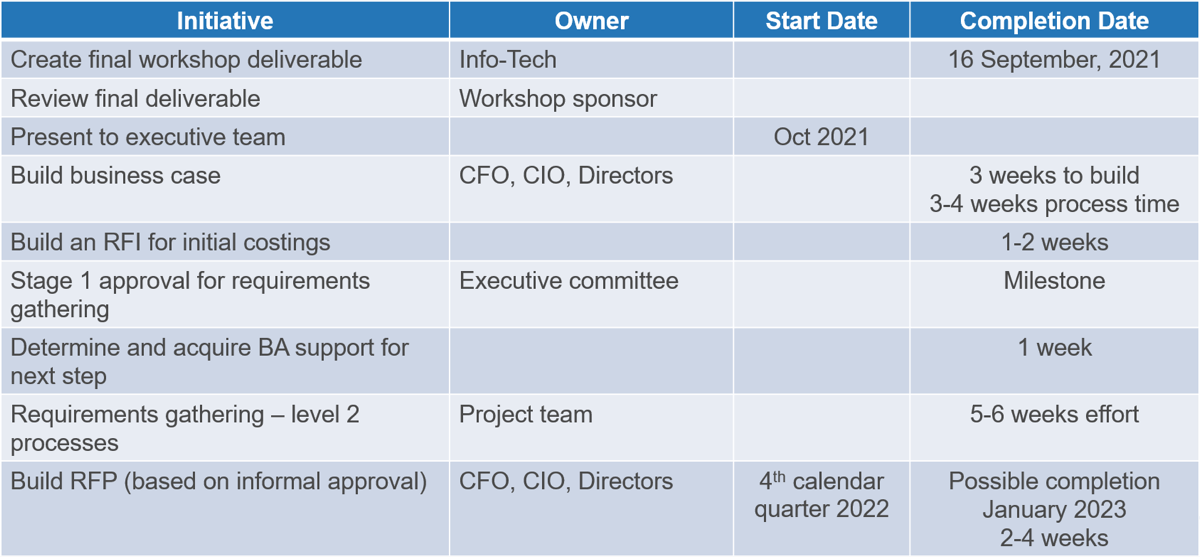
Download the ERP Strategy Report Template
ERP Strategy roadmap
| Initiative | Owner | Start Date | Completion Date |
| Create final workshop deliverable | Info-Tech | 16 September, 2021 | |
| Review final deliverable | Workshop sponsor | ||
| Present to executive team | Oct 2021 | ||
| Build business case | CFO, CIO, Directors | 3 weeks to build 3-4 weeks process time |
|
| Build an RFI for initial costings | 1-2 weeks | ||
| Stage 1 approval for requirements gathering | Executive committee | Milestone | |
| Determine and acquire BA support for next step | 1 week | ||
| Requirements gathering – level 2 processes | Project team | 5-6 weeks effort | |
| Build RFP (based on informal approval) | CFO, CIO, Directors | 4th calendar quarter 2022 | Possible completion January 2023 2-4 weeks |
Activity 4.1.3 – Build a visual roadmap [optional]
1 hour
- For some, a visual representation of a roadmap is easier to comprehend. Consider taking the roadmap built in 4.1.2 and creating a visual.
Record this information in the ERP Strategy Report Template.
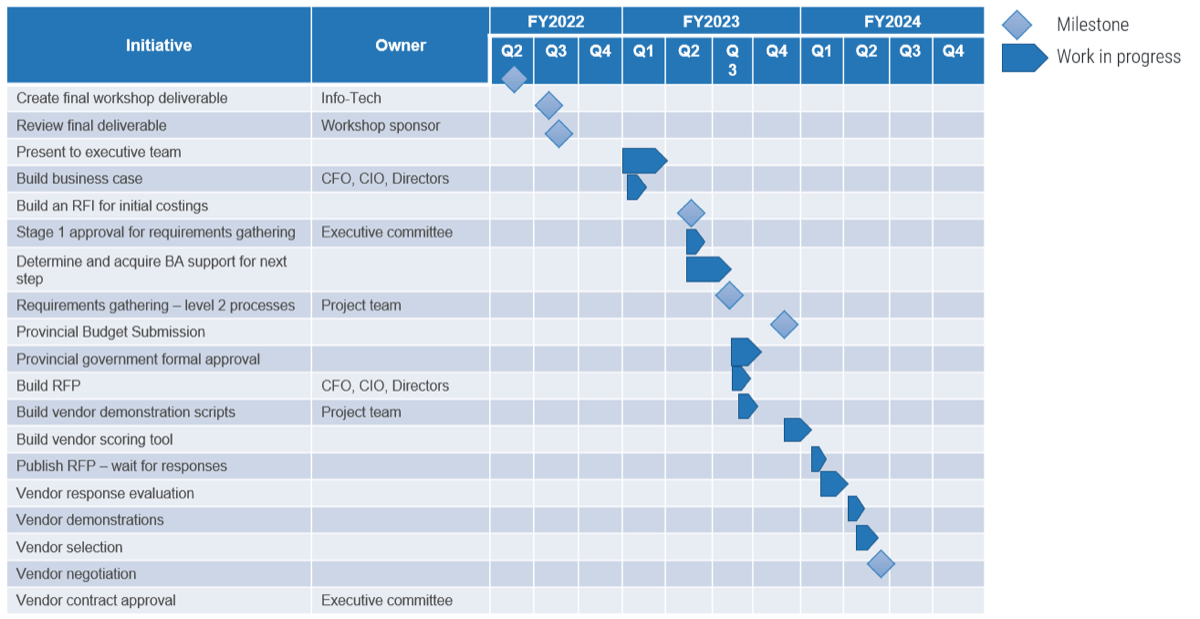
Download the ERP Strategy Report Template
ERP Strategy Roadmap

Step 4.2
Wrap up and present
Activities
- 4.2.1 Communication plan
- 4.2.2 Stakeholder presentation
This step will walk you through the following activities:
- Build a communication plan as part of organizational change management, which includes the stakeholder presentation
This step involves the following participants:
- Primary stakeholders in each value stream supported by the ERP
- ERP Applications support team
Outcomes of this step
- An initial communication plan for organizational change management
- A stakeholder presentation
Effectively communicate the changes an ERP foundation strategy will impose
A communication plan is necessary because not everyone will react positively to change. Therefore, you must be prepared to explain the rationale behind any initiatives that are being rolled out.
Steps:
- Start by building a sound communication plan.
- The communication plan should address all stakeholders that will be subject to change, including executives and end users.
- Communicate how a specific initiative will impact the way employees work and the work they do.
- Clearly convey the benefits of the strategy to avoid resistance.
“The most important thing in project management is communication, communication, communication. You have to be able to put a message into business terms rather than technical terms.” (Lance Foust, I.S. Manager, Plymouth Tube Company)
| Project Goals | Communication Goals | Required Resources | Communication Channels |
| Why is your organization embarking on an ERP project? | What do you want employees to know about the project? | What resources are going to be utilized throughout the ERP strategy? | How will your project team communicate project updates to the employees? |
| Streamline processes and achieve operational efficiency. | We will focus on mapping and gathering requirements for (X) mega-processes. | We will be hiring process owners for each mega-process. | You will be kept up to date about the project progress via email and intranet. Please feel free to contact the project owner if you have any questions. |
Activity 4.2.1 – Communication plan
1 hour
- List the types of communication events and documents you will need to produce and distribute.
- Indicate the purpose of the event or document, who the audience is, and who is responsible for the communication.
- Identify who will be responsible for the development and delivery of the communication plan.
Record this information in the ERP Strategy Report Template.

Download the ERP Strategy Report Template
Communication plan
Use the communication planning template to track communication methods needed to convey information regarding ERP initiatives.
This is designed to help your organization make ERP initiatives visible and create stakeholder awareness.
| Audience | Purpose | Delivery/ Format | Communicator | Delivery Date | Status/Notes |
| Front-line employees | Highlight successes | Bi-weekly email | CEO | Mondays | |
| Entire organization | Highlight successes Plans for next iteration |
Monthly townhall | Senior leadership | Last Thursday of every month | Recognize top contributors from different parts of the business. Consider giving out prizes such as coffee mugs |
| Iteration demos | Show completed functionality to key stakeholders | Iteration completion web conference | Delivery lead | Every other Wednesday | Record and share the demonstrations to all employees |
Conduct a presentation of the final deliverable for stakeholders
After completing the activities and exercises within this blueprint, the final step of the process is to present the deliverable to senior management and stakeholders.
Know Your Audience
- Decide what needs to be presented and to whom. The purpose and format for communicating initiatives varies based on the audience. Identify the audience first to ensure initiatives are communicated appropriately.
- IT and the business speak different languages. The business may not have the patience to try to understand IT, so it is up to IT to learn and use the language of business. Failing to put messages into language that resonates with the business will create disengagement and resistance.
- Effective communication takes preparation to get the right content and tone to convey your real message.
Learn From Other Organizations
“When delivering the strategy and next steps, break the project down into consumable pieces. Make sure you deliver quick wins to retain enthusiasm and engagement.
By making it look like a different project you keep momentum and avoid making it seem unattainable.” (Scott Clark, Innovation Credit Union)
“To successfully sell the value of ERP, determine what the high-level business problem is and explain how ERP can be the resolution. Explicitly state which business areas ERP is going to touch. The business often has a very narrow view of ERP and perceives it as just a financial system. The key part of the strategy is that the organization sees the broader view of ERP.” (Scott Clark, Innovation Credit Union)
Activity 4.2.2 – Stakeholder presentation
1 hour
- The following sections of the ERP Strategy Report Template are designed to function as the stakeholder presentation:
- Workshop Overview
- ERP Models
- Roadmap
- You can use the Template as your presentation deck or extract the above sections to create a stand-alone stakeholder presentation.
- Remember to take your audience into account and anticipate the questions they may have.
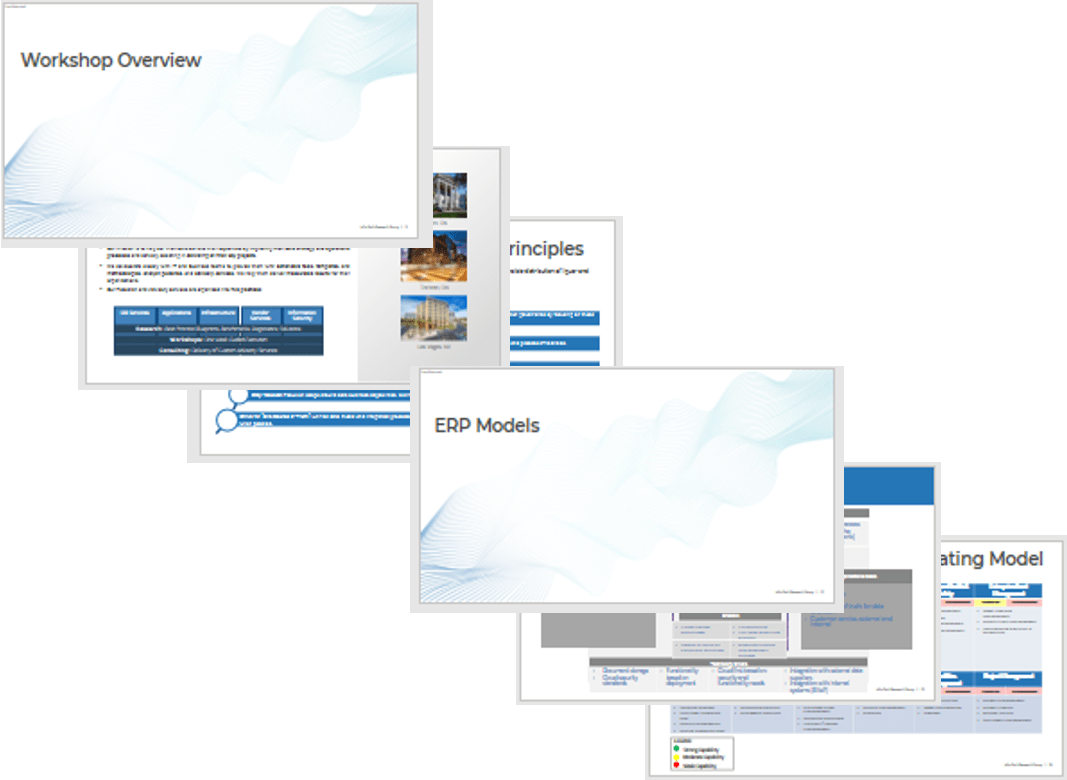
Download the ERP Strategy Report Template
Summary of Accomplishment
Get the Most Out of Your ERP
ERP technology is critical to facilitating an organization’s flow of information across business units. It allows for seamless integration of systems and creates a holistic view of the enterprise to support decision making. ERP implementation should not be a one-and-done exercise. There needs to be an ongoing optimization to enable business processes and optimal organizational results.
Build an ERP Strategy and Roadmap allows organizations to proactively implement continuous assessment and optimization of their enterprise resource planning system, including:
- Alignment and prioritization of key business and technology drivers.
- Identification of ERP processes, including classification and gap analysis.
- Measurement of user satisfaction across key departments.
- Improved vendor relations.
- Data quality initiatives.
This formal ERP optimization initiative will drive business-IT alignment, identify IT automation priorities, and dig deep into continuous process improvement.
If you would like additional support, have our analysts guide you through other phases as part of an Info-Tech workshop.
Contact your account representative for more information.
workshops@infotech.com 1-888-670-8889
Research Contributors
| Name | Title | Organization |
| Anonymous | Anonymous | Software industry |
| Anonymous | Anonymous | Pharmaceutical industry |
| Boris Znebel | VP of Sales | Second Foundation |
| Brian Kudeba | Director, Administrative Systems | Fidelis Care |
| David Lawrence | Director, ERP | Allegheny Technologies Inc. |
| Ken Zima | CIO | Aquarion Water Company |
| Lance Foust | I.S. Manager | Plymouth Tube Company |
| Pooja Bagga | Head of ERP Strategy & Change | Transport for London |
| Rob Schneider | Project Director, ERP | Strathcona County |
| Scott Clark | Innovation Credit Union | |
| Tarek Raafat | Manager, Application Solutions | IDRC |
| Tom Walker | VP, Information Technology | StarTech.com |
Related Info-Tech Research
-
Select and Implement an ERP Solution
Selecting a best-fit solution requires balancing needs, cost, and vendor capability. -
Governance and Management of Enterprise Software Implementation
Don’t outsource your brain. You can’t outsource project accountability to the SI -
Get the Most Out of Your ERP
In today’s connected world, the continuous optimization of enterprise applications to realize your digital strategy is key.
Bibliography
Gheorghiu, Gabriel. "The ERP Buyer’s Profile for Growing Companies." Selecthub. 2018. Accessed 21 Feb. 2021.
"Maximizing the Emotional Economy: Behavioral Economics." Gallup. n.d. Accessed 21 Feb. 2021.
Neito-Rodriguez, Antonio. Project Management | How to Prioritize Your Company's Projects. 13 Dec. 2016. Accessed 29 Nov 2021. Web.
"A&D organization resolves organizational.“ Case Study. Panorama Consulting Group. 2021. PDF. 09 Nov. 2021. Web.
"Process Frameworks." APQC. n.d. Accessed 21 Feb. 2021.
Saxena, Deepak and Joe Mcdonagh. "Evaluating ERP Implementations: The Case for a Lifecycle-based Interpretive Approach." The Electronic Journal of Information Systems Evaluation, 29-37. 22 Feb. 2019. Accessed 21 Feb. 2021.
